Providing FREE vegetarian meals during times of natural disasters
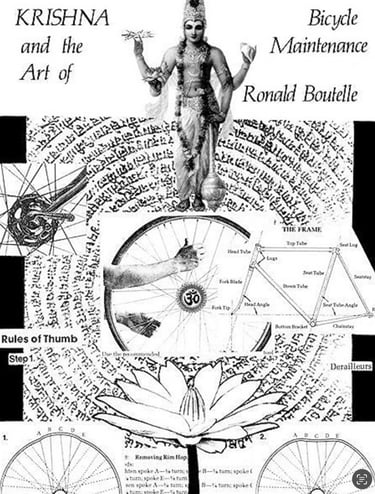

- Chapter Four -
The Triangular Theory of Bicycle Maintenance
As I recall, the first bicycles I worked on belonged to a school teacher who lived down the street from my apartment in Saratoga Springs. They had flat tires and needed some minor adjustments, having been stored in a shed over the long winter.
Without any transportation and wanting a 10-speed of my own, I began to notice in town several used bikes for sale. After shopping around to see what was available, I picked out a real nice one at a used-furniture store for only thirty-five dollars. Being able to find a bicycle so quickly, at such a reasonable price, plus having just made a few dollars repairing my neighbors’ bikes, all started me thinking of opening my own business. Before I knew it I had four or five bicycles in my upstairs apartment, doing the work in the living room.
With the recent opportunity to rent an old garage still on the table, opening a bicycle shop now seemed quite plausible. What finally convinced me, however, was when a friend asked if I would like to go with her to some yard sales, as she needed a cheap television set. Although bicycles were not on the shopping list, I ended up buying two of them for about ten dollars each, and another bike was just given to me. I also bought a front wheel for fifty cents, a seat for a quarter, and for a few more dollars, some other parts dumped in a cardboard box.
Feeling elated with my unexpected fortune and realizing that I could probably find more bargains the following weekend, my friend promised to take me. Sure enough, hardly spending any money at all, once again I was able to purchase many perfectly good parts. I even found an old balloon-tire bicycle for twelve dollars.
So this is how the Adirondack Wheel Works came to life: buying bicycles at garage sales and after fixing them up, selling them for a nice profit. I think at one time I counted nearly sixty bikes in my shop. Before long I was also doing a brisk business buying and selling used parts such as tubes, tires, wheels, handlebars and even selling entire bikes that I had put together from miscellaneous parts.
Wanting to increase business, I got the idea of placing a small ad in the local Pennysaver to attract more customers. Immediately after my ad was printed, car after car came driving up to my shop, unloading all sorts of bicycles for me to fix.
Because my shop was located right next to the YMCA, on several different occasions, bicycle clubs, consisting of around twenty riders from nearby towns would ask if they could store their bikes in my garage overnight. Charging a couple of dollars each, I eagerly agreed to provide them the room.
As time went on, people were bringing me all sorts of problems to repair: flat tires, bent wheels, derailleur’s that needed adjustment, brakes that wouldn’t work, stiff and broken cables, missing and broken spokes, and just about every other problem imaginable.
Since most repairs took so little time and inexpensive to complete, I found that the secret to getting paid a good wage was to spend an extra fifteen minutes, or so, dedicated to cleaning and shining my customer’s bike, even though not asked to. On more than one occasion someone would come to pick up their bicycle but was unable to recognize it. It would look brand-new, and all that was required was a few minutes of my time. When people saw their bicycle smartly sitting there in my showroom, they never hesitated to pay what I asked.
After putting in hundreds of hours repairing bicycles, I suddenly began to get realizations about what I was actually doing when solving the various problems that confronted me. I didn’t consciously set out to formulate any of these concepts, but rather, certain ideas just came to me. In time I noticed that there were three prominent factors involved in performing any repair, a simple concept, but I gave it a fancy title: The Triangular Theory of Bicycle Maintenance.
The three factors correspond to the three points of a triangle and are: the right knowledge, the right parts, and the right tools. Although such an analysis was mostly automatic, in the long run it did help to spell the concept out.
Over time I discovered that with my more difficult problems, I could do the work more smoothly by applying this theory. Also, on account of having opened the Adirondack Wheel Works without any formal training or experience, no doubt I was being heavily taxed at times to quickly figure out what to do. This formula narrowed the problems into specific categories that I could then deal with in a systematic way.
In order to better appreciate the deeper and spiritual aspects of this chapter, I would like to take a close look at this theory and thoroughly examine it. To begin with, in the “center of the triangle,” we find the bicycle mechanic.
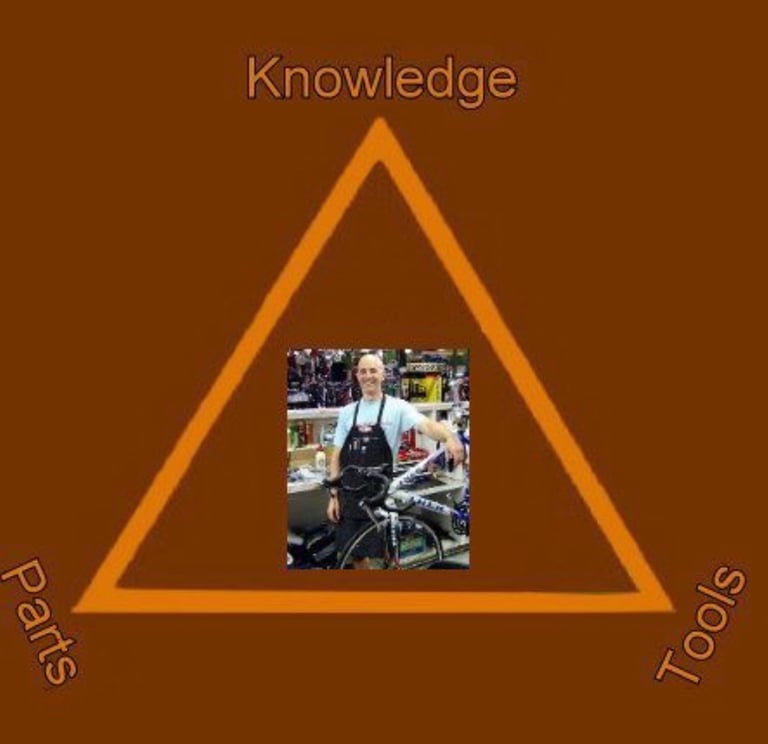

The Triangular Theory of Bicycle Maintenance
photo by: Andrew Dressel (Wikipedia License)
By applying his knowledge, his parts, and his tools, he is able to make the necessary repairs. In his shop, he is the most important factor, the conscious force that puts life both into his business and into the broken bicycles that are brought to him.
Outwardly, the bicycle mechanic might be 28 years old; wearing a white t-shirt and Yankees baseball cap. His father works for General Electric in Schenectady, New York, and his grandfather had worked in a sawmill most of his life, before dying from cirrhosis of the liver. His family has always had a drinking problem.
As for his great grandfather, he had immigrated to America from England by ship, working off his passage as a deckhand. Having come from a family of sailors near Liverpool, he felt right at home aboard “the old sailor,” but once he landed in America he never set foot on one again.
There’s even a long forgotten ancestor who cooked for the Queen of England, while another was a renowned blacksmith; an especially famous hinge maker whose handiwork can still be seen on many of the massive gates adorning castles and churches throughout Great Britain.
But rather than these superficial trappings, it is the bicycle mechanic’s “inner person” that we want to examine. We need to understand his vision and what makes him tick. Factually speaking, when a broken bicycle is put in front of him, he is comparing what he sees to a much more subtle picture in his mind: that, of a perfect bicycle.
For example, if the wheel is bent, he knows what a perfect wheel looks like and how it is supposed to “behave.” He knows that it is supposed to spin without wobbling back and forth, easily turning on so many ball bearings, free of noise. He knows it should have so many spokes, tight and straight, and the rim not damaged. When he picks up the broken wheel, this comparison is the internal process going on inside him.
The master bicycle mechanic only deals in perfect bikes, and after he touches a broken bicycle it becomes like new. We all know that we don’t let just anyone touch something that is broken. If we own something and it’s not working properly and someone suddenly decides to pick it up, more often than not he’ll get yelled at: “Don’t touch that, you’ll break it!” This is why we take it to a good mechanic because we know that after he touches it, the object will be returned like new.
Intrinsic any product produced by man (such as a bicycle) you’ll find that there is a person, an idea, and a blueprint. The master bicycle mechanic thus understands the original idea that the inventor of the bicycle had. In other words, he is familiar with the bicycle’s blueprint. This is what he is looking at from within. Internally, within his mind, he sees a perfect bike. This is his intelligence. When he looks at a bike, immediately he can discriminate: “Oh, this should be tight, this shouldn’t be bent, this should spin more freely, there’s too much cable here, this is worn out, this is missing, this is too loose.”
Another quality concerning our bicycle mechanic is his strong commitment to get the job done. This flavors his psyche and acts like a catalyst. Call it love of bicycles, love of money, a need for admiration and distinction, or whatever. The fact remains that he is motivated to repair bicycles. He may just like to fix things. More than likely, however, there are several factors behind his determination. Without this inner drive his abilities would just lie dormant and nothing would get repaired. So a good bicycle mechanic is eager to get the broken bike working again like new.
To begin the repair, the bicycle mechanic first reaches out and touches the exact spot where the problem exists. This initiates the transformation that is about to take place. Paying close attention, he employs his tools to take off broken parts; repairing or adjusting them, or installing new ones.
His assortment of TOOLS are vital to his business and he keeps them clean, hanging neatly on the wall. He has everything he needs to work on any bicycle, even ordering from companies that specialize in all sorts of exotic bicycle tools. What he is doing, then, is touching the broken parts with these tools. However, if for some reason he doesn’t have the proper tool, he won’t be able to make the repair. We all know this. If you don’t have a hammer, how are you going to drive the nail? This is why tools are such an important factor in the theory.
Once I decided to open my bicycle shop I purchased many tools. Of course, a mechanic who possesses a lot of ingenuity can, on occasion, make the necessary tool right on the spot, but there’s no guarantee. When there is no tool available, the repair will come to a screeching halt.
PARTS, which constitute the third point of the triangle, are equally important. After all, how can the bicycle mechanic repair the bike if he doesn’t have the replacement parts? What the bicycle mechanic is trying to do, then, is replace bad parts with perfect parts, be they new or reconditioned.
A bicycle really consists of many perfect parts, all working in unison to produce the result that its inventor had intended: to travel down the road smoothly and quietly, with as little effort as possible. You could say that the perfect bicycle pleases its creator by behaving like it was designed to operate. The master bicycle mechanic is using everything at his disposal to make sure that every part is a perfect fit and working properly. With his “third eye” on his “internal blueprint,” he only deals in perfect parts.
Hopefully, you can now see how this theory works. If the part is available but the proper tool can’t be found (even if one knows exactly what to do), how will it be possible to proceed? On the other hand, if you have the right tool, and you know what to do, but the bicycle shop is out of the part you need, how can you go on? The third scenario is that you have the right part and you have the right tool, but you lack the KNOWLEDGE to figure out how the darn thing comes off. Not knowing what to do can also stop you cold!
Take, for example, this problem that once happened to me. I had a bike and I wanted to replace the stem and handlebars. At a garage sale I had found the replacement parts in mint condition, and I had more than enough tools to do the job.
It was an older bike; the kind that you stopped by pushing backwards on the peddles. All that I had to do was loosen the large nut on top of the stem and pull the entire assembly out, or so I thought. But when I did this, even though the neck was loose and I was able to grab hold of the handlebars and turn everything with ease, no matter how hard I pulled upward, the stem wouldn’t budge. Somehow the stem was stuck in its vertical position. My problem was a lack of knowledge and regardless of having more than enough tools at my disposal and the two new parts sitting on my bench, my best efforts were quickly checked.
Later, a friend at another bike shop gave me the information I needed. What I needed to know was this: “Loosen the nut on top of the stem (which is actually the head of a very long bolt), but keep unscrewing it until the bolt comes up about one inch.


Handlebar stem with expander wedge cone
Then, using a hammer, give the top of the bolt (the nut) a sharp tap downwards to loosen a specially designed lock-nut that is out of sight and screwed onto the end of it; down inside the head tube. The stem then pulls out.” This is how a lack of knowledge can stop a repair and why knowledge is just as important as one’s tools and parts.
During the time I kept the Adirondack Wheel Works open for business, I resolved countless challenges. There was always a new bicycle to work on with its own set of peculiar problems. But any problem, it seemed, could be solved by applying The Triangular Theory of Bicycle Maintenance. I had my tools, plenty of spare parts, and above all I have been blessed with a fair amount of common sense.
But what about ALL problems? Let us not forget, there are problems starting with a little “p” and problems starting with a big “P”. What about the really big problem? What about death?
*** ** ***
While visiting Bombay (Mumbai), India, in the fall of 1973, His Divine Grace A.C. Bhaktivedanta Swami Prabhupada told his guests, “Nobody wants to die. Is that not a fact? Nobody wants to become old. Nobody wants to get an old body like me. Rheumatic troubles. Nobody wants. But I am forced to accept. I was also a young man like you. I would like to go back again to that young life, but there is no possibility. The question is that I am eternal, as spirit soul. I do not die after the annihilation of this body. But why I am forced to accept another body, which will (again) be annihilated? The real problem of life is how to solve the repetition of birth, old age, disease, and death.” (BHAKTIVEDANTA SWAMI PRABHUPADA, Conversations With Shrila Prabhupada, Vol. 6, p. 120, © BBT-Int’l 1989)
History has well documented man’s quest for immortality, including a remarkable discovery in 1863 by E. G. Squire, an American. He liked to explore and while working as a diplomat in Peru he found a two thousand-year-old human skull with six very small wires inside it, along with a rectangular opening chiseled in it; “strongly suggesting brain surgery.” But death still caught up to that poor fellow. (ERIC VON DANIKEN, The Gold of the Gods, p. 179, Bantam Books, 1974)
Even though modern medicine has made enormous strides in reducing the sufferings which attack our bodies; with artificial hearts (parts), laser surgery (tools), and huge research centers (knowledge), still, immortality escapes our best attempts. A person may live an extra fifteen years or so using all our modern techniques, but that’s about the limit before once again the jaws of death open wide.
Death means that you can’t get up and go about your business. A broken bicycle means that it cannot be ridden. Plus, death (like a flat tire) can occur at any moment, taking us away from the ones we love and the things we cherish, almost as if at gunpoint. And who is powerful enough to turn death away? Night lights won’t stop it. Steel bars on the windows can’t keep it from entering. A handgun under the pillow is useless. An expensive alarm system won’t save us either, and being the president of a great nation, or a famous general, doesn’t mean you can simply order it away.
No, death takes both the cruel and the innocent; those who are prepared for it and those for whom death is the furthest thing from their mind. We all know the terrible examples. A small child accidentally run over. A mother and her three children killed instantly when a drunk suddenly pulls out in front of them. One second alive, the next dead. I once heard on the news that in New York City a lady was on her way home, coming down an escalator to catch the bus,just like she had for the past seven years. All at once the bottom landing of the escalator malfunctioned, opening up and sucking her into a very unexpected and horrible death.
What about the problem of death? Soon we will all have to confront it. Can this real problem (P) of life, just mentioned by Shrila Prabhupada, be solved by applying The Triangular Theory of Bicycle Maintenance? Who is the mechanic and what are his tools? What could possibly be the parts that he uses and what needs adjusting? Just as we did in the beginning of this chapter, let us again examine the various aspects: the right knowledge, the right tools, and the right parts.
At the heart of the triangle, once more we discover “the master mechanic,” although now I would like to call him the spiritual master. Outwardly he may be dressed in long saffron robes, his face and arms deeply tanned, and wearing a beautiful flower garland around his neck. There’s not much hair, he’s well over seventy, and his forehead has been decorated with sandalwood paste.
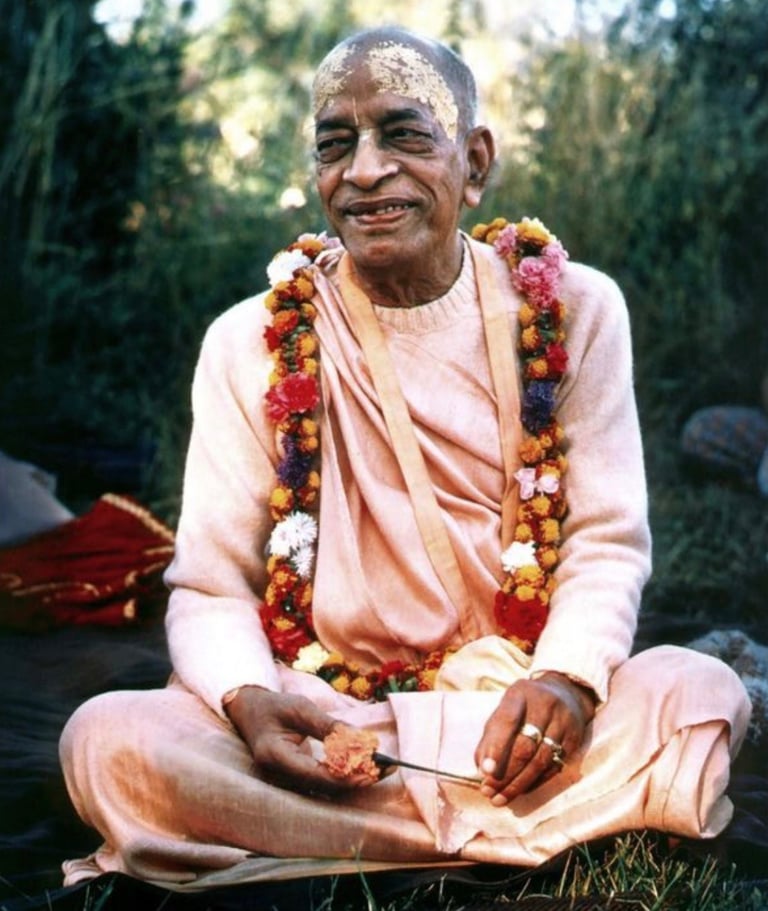

Shrila Prabhupada - The Spiritual Master
Just as we studied the bicycle mechanic, we need to look beyond the spiritual master’s outward appearance and discover the “inner man.” Who is he? What makes him so qualified? What are his spiritual tools and what are the spiritual parts he works with? What does he know that I don’t know, or that you don’t know? Why is he so enlivened, strongly committed to his work, and yet, so peaceful?
One thing is for certain here: I’m not speaking about changing a simple flat tire, but rather a very serious problem that faces us all. If The Triangular Theory of Bicycle Maintenance is going to solve the problem of repeated birth, old age, disease and death, then every aspect of it must have spiritual roots, directly in touch with God, the master of death. (REVELATIONS 1:18: “I have the keys of hell and of death.”)
Although our bicycle mechanic commands a certain amount of authority and respect amongst his customers and friends, his sphere of influence is actually very narrow and short lived; nothing in comparison to the position of the spiritual master. His glorious credentials are revered throughout the Vedas (Scriptures), establishing not only his unquestionable divinity, but also his jurisdiction over death. Since the spiritual master’s authority originates from our Holy Father, let us take a closer look at God, in general terms.
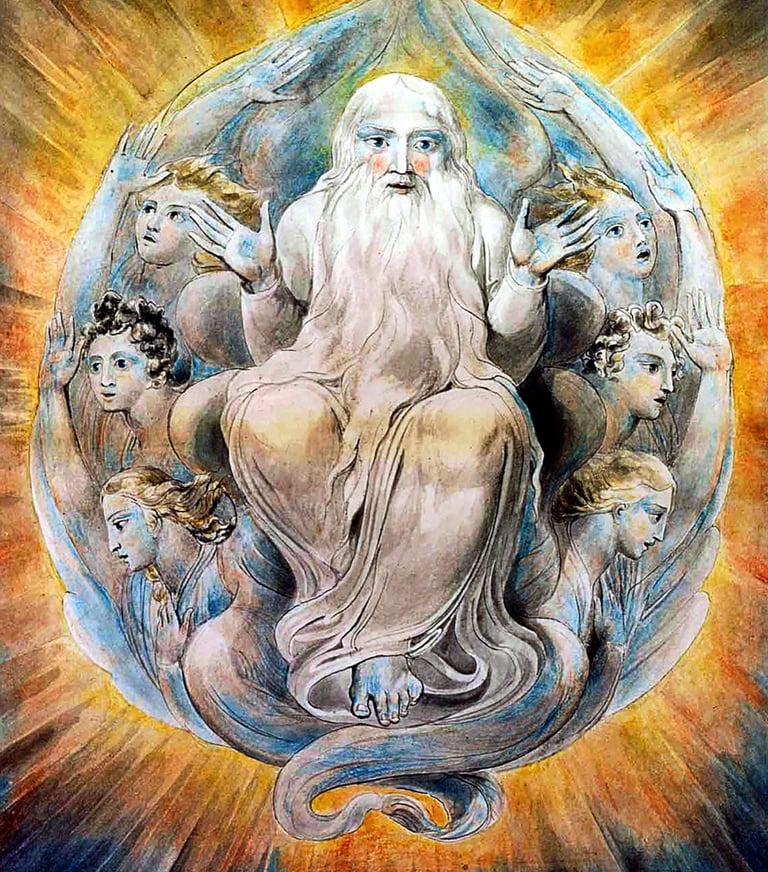

God by William Blake (1805)
When referring to God, there are several important aspects concerning Him that are important to understand. For one, God is without source, meaning that nothing caused God to come into existence. If God were created, then that which created Him would be superior. Therefore, in his opening prayers, Shrila Vyasadeva (SHREE-la V-YAH-sa-dave – the author of the Shrimad Bhagavatam), says that he worships the Lord because He is the primeval cause of all causes, fully independent, because there is “no other cause”beyond Him. (SHRIMAD BHAGAVATAM 1.1.1; Bhaktivedanta Swami Prabhupada)
This is substantiated in the Bhagavad-gita wherein the Lord states (7.19): “I am the cause of all causes.” (9.5): “My Self is the very source of creation.” (10.3): “I am unborn.” (7.7): “Everything rests upon Me, as pearls are strung on a thread.” (Note: the numbers referto chapter and verse. BHAGAVAD-GITA AS IT IS, by A.C. Bhaktivedanta Swami Prabhupada)
In the Holy Bible there are similar verses:
COLOSSIANS 1:17: “It is His power that holds everything together.”
REVELATIONS 1:8: “I am the A (Alpha) and the Z (Omega), the Beginning and the Ending of all things.”
COLOSSIANS 1:16: “Christ himself is the Creator who made everything in heaven and earth.”
By definition, God is the supreme authority. This means that no one can check or interrupt the Lord or His activities. There is no authority above God with greater command, supremacy, or mastery. He is not like one of the little gods coming to America from India, proudly voicing his great divinity but when reaching the airport, must submit to a body& luggage search by a TSA agent, just like everyone else. No, our Almighty Lord is not that kind of a God.
The saints have long ago identified the Lord’s greatness and categorically, God reigns supreme throughout creation. BHAGAVAD-GITA (2.2): “Although there are many personalities possessing the qualities of Bhagavan (bog-a-von: God), Krishna is the supreme because none can excel Him.”
This is what makes God (Krishna, or Krsna in ancient Sanskrit) so enchanting. He is the most attractive personality that exists, making our Lord the most famous person. While it is true that there have been many famous personalities, such as Cleopatra, Sir Winston Churchill, Elvis Presley, and Dr. Martin Luther King, no one is more famous than God. If this were so, then that person would command a greater position than God, which by definition cannot exist.
Power is another attractive feature which the saints have identified. Physically, there are many powerful people, able to perform many Herculean feats, but all are dwarfed by the power of God. At night, in any city, there are many powerful lights. However, when the morning sun arrives on the scene, no matter how powerful the light bulb, its intensity becomes dwarfed and is turned off as useless. Similarly, although there are many invincible personalities who impress others with their enormous strength, the most powerful person is the Supreme Personality of Godhead (Lord Krishna) creating billions of suns, planets and moons simultaneously.
BHAGAVAD-GITA (7:10-11 & 15:12): “Know that I am the prowess of all powerful men. I am the strength of the strong. The splendor of the sun, which dissipates the darkness of the whole world, comes from Me.”
Another opulence that attracts our attention is beauty. We have all experienced the effect of coming in contact with an especially beautiful woman, or very handsome man. Especially the beauty of women is glorified in our society with their charming elegance splashed over the covers of countless magazines. But again, no one is more beautiful than God. BRAHMA-SAMHITA (bra-ma sum-hee-TA) (5.30): “His unique loveliness charming millions of Cupids.”
Wealth is another possession that commands great respect. Having wealth, one is able to attract so many people. Sometimes you will see a man who is physically quite ugly, but due to his enormous wealth, holding onto his arm is a very beautiful woman.
Along with the other opulence’s I’ve just mentioned, similarly, no one has more wealth than God. This is why the Lord is so often referred to as “the husband of the goddess of fortune” and why, “whenever and wherever the Lord is present, the goddess of fortune is also there, because the goddess of fortune never lives without her husband.” (BHAGAVAD-GITA AS IT IS, p. xi, A.C. Bhaktivedanta Swami Prabhupada, © BBT-Int’l, 1984)
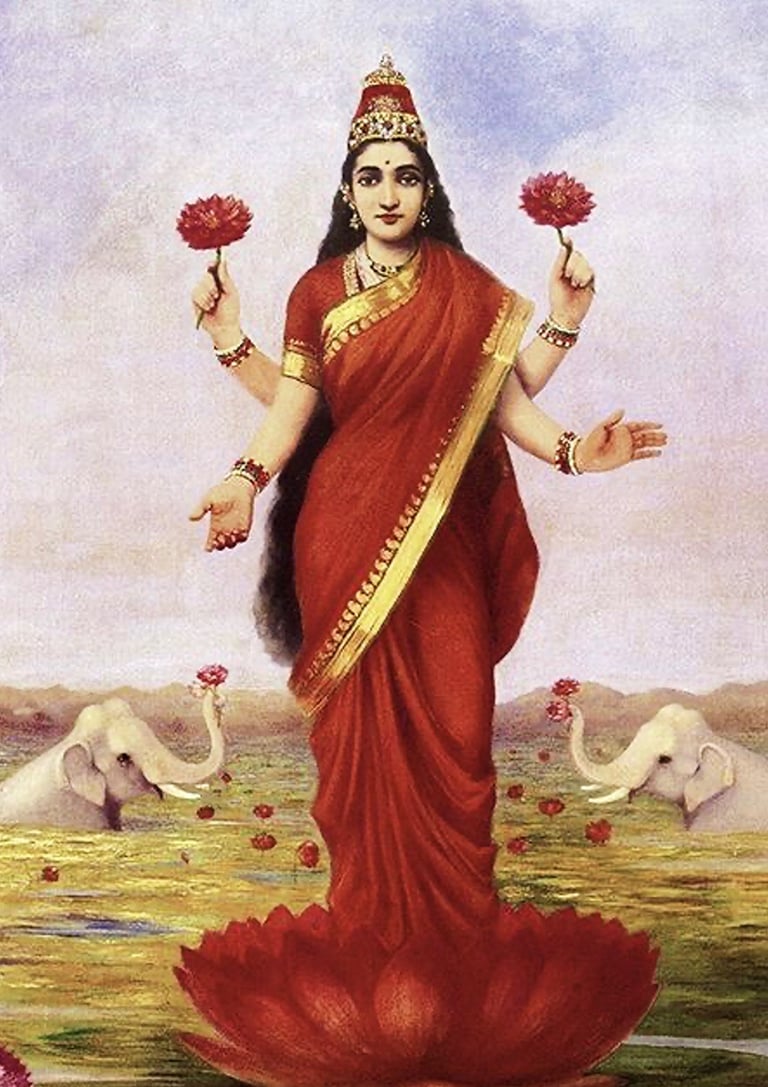

Laxmi: the Goddess of Fortune
Wisdom (or intelligence) is another opulence that makes people attractive. I remember, as a young boy, watching a television program with my father called, The Sixty-Four Thousand Dollar Question. The way the show worked was that a person was placed in a soundproof box and given a series of difficult questions to answer; progressively becoming more and more difficult. The answer to the final and most difficult question was worth $64,000.00, but if he failed then all the money he had won would have to be given up.
This show aired back in the mid fifties and this one particular fellow began answering all the questions, week after week. As you can imagine, besides totally astounding everyone with his amazing knowledge, he was making enormous sums of money. Every time the show played, across America, our nation sat glued to their television sets to watch this incredible genius. People are attracted to intelligent people. But then again, compared to the intelligence of our Lord, no one can outwit His supreme wisdom.
As far as the television show, it was discovered that all along the producers had been slipping answers to their “genius” (Teddy Nadler), immediately creating a national uproar. (Note: at the end of this book I have described for you a wonderful pastime of the Lord that illustrates His supreme intelligence.)
Finally, there is renunciation, or giving up worldly pleasures, which is another distinction that people find attractive. A perfect example is Jesus Christ who set aside his will to solely concentrate on serving his Heavenly Father. JOHN 4:34: “My nourishment comes from doing the will of God.”
Other outstanding examples of individuals who have attracted the attention of the world by their renunciation are Mother Theresa and Lord Buddha. We can especially appreciate the attractive nature of renunciation by studying the thrilling lives of these great saints. However, these same individuals unanimously agree that none is more renounced than their Holy Father, God. BHAGAVAD-GITA (18.78): “Krishna is the master of renunciation.”
In his many lectures and books, Shrila Prabhupada has helped illuminate our understanding of God: ”Krishna is the Supreme Personality of Godhead. Outside the principle of all-attraction, there is no meaning to the word ‘Godhead.’ One who is in possession of all six of these opulence at the same time (fame, power, beauty, wealth, intelligence, renunciation), who possesses them to an unlimited degree, is understood to be the Supreme Personality of Godhead.(KRISHNA THE SUPREME PERSONALITY OF GODHEAD, p. xi, A.C. Bhaktivedanta Swami Prabhupada , © BBT-Int’l, 1984)
*** ** ***
This chapter continues defining God: the supremely attractive person. This is, after all, what the Sanskrit word, “Krishna” means. As far as what God looks like, He has unlimited spiritual forms, but of all His divine forms, His primeval form, called Govinda (go-vin-da) is the most attractive: melting the hearts of His beloved devotees.
SHRIMAD-BHAGAVATAM (2.2.34): “The great personality Brahma, with great attention and concentration of the mind, studied the Vedas three times, and after scrutinizingly examining them, he ascertained that attraction for the Supreme Personality of Godhead Shri Krishna is the highest perfection of religion.”
The “Hymns of Brahma,” which glorify Lord Krishna, are some of the most exquisite prayers ever offered to God. Here are just a few lines: “Krishna who is known as Govinda is the Supreme Godhead. He has an eternal blissful spiritual body. He is the origin of all. He has no other origin and He is the prime cause of all causes. I worship Govinda, the primeval Lord, the first progenitor who is tending the cows, yielding all desire, in abodes built with spiritual gems, surrounded by millions of purpose trees (trees that grant you any wish), always served with great reverence and affection by hundreds of thousands of gopis (go-peas: devotees). I worship Govinda, the primeval Lord, who is adept in playing on His flute, with blooming eyes like lotus petals, with head bedecked with peacock’s feather, with the figure of beauty tinged with the hue of blue clouds, and His unique loveliness charming millions of Cupids.” (SRI BRAHMA-SAMHITA, Bhaktisiddhanta Sarasvati, Shri Brahma-samhita, texts 1, 29, 30, © BBT-Int’l, 1985)

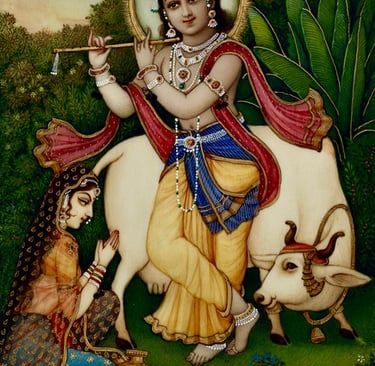
Govinda
by: B.G. Sharma
A broken bicycle and the results of having it touched by an expert bicycle mechanic is one thing, but nothing compared to allowing yourself to be touched by the spiritual master. To better understand exactly who he is, let us turn again to the word of God and discover His opinion on the divine position of this great personality.
“One should know the (spiritual master) as Myself and never disrespect him in any way. One should not envy him, thinking him an ordinary man, for he is the representative of all the demigods. My dear King, a disciple has to accept the spiritual master not only as spiritual master, but also as the representative of the Supreme Personality of Godhead and the “Supersoul: In other words, the disciple should accept the spiritual master as God because he is the external manifestation of Krishna.” (The localized aspect of the Supreme Lord; the indwelling witness and guide who accompanies every conditioned soul). (THE SPIRITUAL MASTER AND DISCIPLE, Subhananda dasa, © BBT-Int’l, 1978)
“According to the deliberate opinion of all revealed Scriptures, the spiritual master is non-different from Krishna. Lord Krishna in the form of the spiritual master delivers His devotees.” (THE SPIRITUAL MASTER AND DISCIPLE, Subhananda dasa, © BBT-Int’l, 1978)
JOHN 1:1/2: “Christ is himself God.”
So this is the qualification of the spiritual master, perfectly capable of solving the problem of repeated birth and death. “Actually, we are giving the technological knowledge by which one stops death. This is Krishna Consciousness.” (CONVERSATIONS WITH SHRILA PRABHUPADA, Vol. 6, p. 119, A.C. Bhaktivedanta Swami Prabhupada, © BBT-Int’l, 1989)
To assist in presenting the spiritual master’s introduction, I would like to repeat a story that I heard on the evening news. The story was about a cheese factory in France that was closing its doors after four hundred years, simply because there was no one qualified to become the next “Master Cheese Maker.” Throughout all those centuries, you see, their secret cheese recipe had been handed down through an unbroken chain of “Master Cheese Makers.”
The way it worked was that eventually, an especially dedicated and talented worker would be entrusted with the responsibility of perpetuating the integrity of the cheese mill, and over the years he, in turn, would pass on what he had learned from his “master” to his own apprentice. The result being that the cheese made today would taste exactly like the cheese made in 1592. If an apprentice ever took it upon himself to change the formula for making the cheese, the greatest offense would occur, spoiling the ancient tradition started by the founder of the factory, long, long ago.
In spiritual terms, this unbroken line of teachers is called the Disciplic Succession, or, in Sanskrit, Parampara (pa-rom-pa-raw). In the Bhagavad-gita As It Is (4:2), Lord Krishna tells Arjuna, “evam paramparam praptam,” thus explaining to him that the supreme science He is about to communicate to him was originally received through a chain of Disciplic Succession.
The Disciplic Succession, then, is like one’s family tree and not meaning to belittle one’s natural mother and father, it is this spiritual lineage that we need to focus on. Neither does this mean that the parents of Shrila Prabhupada have been ignored. Shrila Prabhupada’s mother and father were great figures in their own right, raising their young son with the great love and attention. Shrila Prabhupada father’s name was Gour Mohan, a Calcutta cloth merchant.
Satsvarupa Dasa Goswami writes in his book, Prabhupada, He Built a House in Which the Whole World Can Live: “Gour Mohan was a pure Vaishnava (vie-sh-nov: devotee of Lord Krishna), and he raised his son to be Krishna (God) conscious. Since his own parents had also been Vaishnavas, Gour Mohan had never touched meat, fish, eggs, tea, or coffee. His complexion was fair and his disposition reserved.
“At night, before locking his cloth shop, he would set a bowl of rice in the middle of the floor to satisfy the rats, so they wouldn’t gnaw the cloth in their hunger. On returning home he would read from Chaitanya-Charitamrita (chay-ton-ya cha-ree-TOM-ree-ta) and Shrimad-Bhagavatam (the main Scriptures of Bengali Vaishnavas), chant on his japa (ja-pa) or rosary beads, and worship the Deity (statue-like form) of Lord Krishna.
“A picture always remained in Prabhupada’s memory of his father’s devotional worship of Lord Krishna. He would recall how his father used to come home late at night from the cloth shop and faithfully perform his worship of Lord Krishna before the home altar. ‘We would be sleeping,’ Prabhupada recalled, ‘and father would be doing arati (r-tee). We would hear the ding, ding, ding; we would hear the bell (ceremony) and wake up to see him bowing down before Krishna.'” (PRABHUPADA, HE BUILT A HOUSE IN WHICH THE WHOLE WORLD CAN CAN LIVE, Satsvarupa dasa Goswami, pp. x-xi, © BBT-Int’l, 1983)
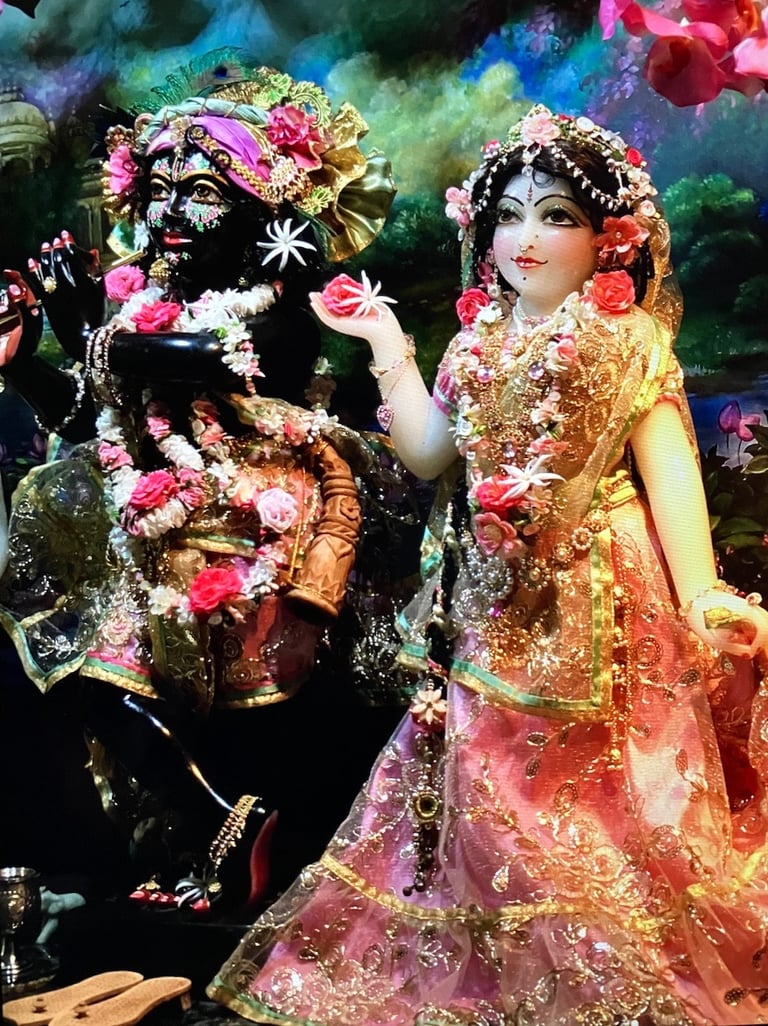

Radha-Krishna Deities
Viewed from a distance, the family tree of our bicycle mechanic, which has its roots deeply sunk into the soil of humanity, may appear similar to the “tree of disciplic succession;” if the two lineages were drawn out on a large piece of paper and viewed from a distance.
But upon closer inspection, the names, of course, would be vastly different; Linkletter vs. Patel, English vs. Sanskrit, India vs. Europe, etc. First examining the roots of our bicycle mechanic’s family tree, the main trunk can be traced back to “Attila the Hun” and a maiden he had raped in 447 A.D.
From this starting point everything is divided and branched out until a colossal family tree is produced, bringing us up to date in the person of our master bicycle mechanic.
However, compared to the disciplic succession and Shrila Prabhupada’s spiritual roots, there’s really no comparison, at all. As I have said, if The Triangular Theory of Bicycle Maintenance is going to solve the problem of death, then every aspect of it needs to be fully blessed, directly linked to God Almighty and His mercy. None of this can be vague, or my personal opinion, but rather it must be established fact and based on Scripture. Now let us look at the all important, knowledge, parts, and tools.
It mentions in the Holy Bible, ROMANS 11:16: “If the roots of the tree are holy, the branches will be too.” Just as the roots of a tree deliver life giving water to all its parts, the “tree of disciplic succession” bestows upon mankind a holy lineage of spiritual masters, originating with God and blessing the entire world with their presence.
“This is the method of disciplic succession: Krishna imparted knowledge into the heart of the first created living being (Brahma) within the universe. Brahma then imparted those lessons (knowledge) to his disciple (Narada), and Narada imparted that knowledge to his disciple, Vyasadeva. Vyasadeva imparted it to Madhvacharya and from Madhvacharya the knowledge comes down to Madhavendra Puri …to Ishvara Puri, and from him to Chaitanya Mahaprabhu.” (SRI CHAITANYA-CHARITAMRITA, A.C. Bhaktivedanta Swami Prabhupada, introduction, © BBT-Int’l, 1974)
Regarding the exact identity of Lord Chaitanya (1486-1534): “Govinda personally appears as Chaitanya. The author of the Chaitanya-Charitamrita most emphatically stresses that Lord Chaitanya is Krishna Himself. He is not an expansion of (Krishna’s forms). He is (Govinda).” (SRI CHAITANYA-CHARITAMRITA, A.C. Bhaktivedanta Swami Prabhupada, Adi-lila 2:22, © BBT-Int’l, 1974)
Apart from the relevant scriptural evidence presented by the author of the Chaitanya-Charitamrita, there are many other statements regarding Lord Chaitanya being the Supreme Lord. For example, in the Krsna-Yamala it is predicted: “I shall appear in the holy land of Navadvipa (Chaitanya Mahaprabhu’s actual birthplace) as the son of Sacidevi: (the name of Lord Chaitanya’s actual mother).
Furthermore, within the pages of the Brahma-Yamala there is this statement: “Sometimes I personally appear on the surface of the world in the garb of a devotee. Specifically I appear as the son of Saci in Kali-yuga (the earth’s present time cycle) to start the Sankirtana Movement: (the congregational singing of the Lord’s Holy Names).
It’s exciting to point out here that to step back in time only 550 years to the “second root” of the “tree of disciplic succession” (Lord Krishna’s appearance as Lord Chaitanya), is easily accomplished with the many detailed accounts compiled by the scholars and contemporaries of His day. Not only is the root of the “tree of loving devotion” shown to by throughly holy, it has been blessed with the appearance of Lord Krishna again, this time as Chaitanya Mahaprabhu(“maha” means, great …and “prabhu” means, master).
“If the roots of the tree are holy, the branches will be holy, too.” In fact, after examining the “tree of disciplic succession” we can see many such branches; each representing a prominent spiritual master; each connected directly to Lord Krishna. Although I would like to, it would be impossible in a book of this size to give even a partial description of all their illustrious lives. However, I will mention a few of them. These condensed notes are not necessarily in chronological order, but instead I have simply selected a few stories from the many outstanding spiritual master whom I have studied.
(The following details are found in, THE LIVES OF THE VAISHNAVA SAINTS: SHRINIVAS ACHARYA, NAROTTAM DAS THAKURA, SHYAMANDA PANDIT, by Steven J. Rosen):
1. “Shrinivas Acharya developed his inner meditation to such a degree that he began to inadvertently bring tangible paraphernalia from these meditations when returning to external consciousness. For example, Bhakti-ratnakara (written by the Vaishnava Saint, Narahari Chakravarti) relates that once, while meditating on Lord Chaitanya’s Lila (lee-la: pastimes), Shrinivas saw that he was actually worshiping Lord Chaitanya, Himself, who was seated on a beautifully jeweled throne. In Shrinivas’s meditation, he approached the Lord and reverentially anointed His body with fragrant sandalwood paste. Then he placed a garland of aromatic flowers around the Lord’s neck and began to carefully fan Him with a chamara (yak tail fan).”


– chamara –
photo by: Atiprada Guara Das
“As Shrinivas served the Lord in this way, he could not keep his composure and looking at the Lord’s magnificent form he began to exhibit ecstatic symptoms. This pleased Lord Chaitanya, who then took the same garland of flowers that Shrinivas had given Him and placed it around Shrinivas’s neck. After the Lord made this loving gesture, Shrinivas’ meditation broke but the garland was still adorning his own chest. Its fragrance was unlike anything he had ever experienced. He quickly took off the garland and hid it in order to conceal this confidential pastime.” (NOTE: read my free book, “Abandoned,” for a very similar incident involving a Spanish Nun and Indians from Texas. The link is located at the end of this book)
“This same kind of experience often occurred for Shrinivas. Bhakti-ratnakara describes that once during Shrinivas’s intense meditations, he envisioned himself at the side of Radharani, as Radharani and Krishna were taking part in the Holi Kela Festival. (ROD-HA-ronnie, is Lord Krishna’s eternal companion).
“This is a joyous event wherein Radha and Krishna playfully throw colored dyes at each other. Shrinivas saw in his meditation Radha and Her intimate gopi friends (young cowherd girls) flinging dyes and squirting all kinds of colored waters at Krishna, bombarding Him from all directions and Krishna, in turn, threw various kinds of dye at them. As this loving battle reached its highest point, the gopis looked to Shrinivas gesturing that he (she) should come to their rescue. (Note: When Shrinivas was experiencing this spiritual trance, he was in the body of Mani Manjari, who is a gopi or cowherd girl).
“Mani Manjari then started to quickly supply Radhika with ample quantities of multi-colored powders. Radhika and the gopis used these against Krishna, but He would not be defeated so easily. He returned their attempts with even greater attacks, the conflict becoming so furious that the ground began to shake. In the midst of this irrepressible enjoyment, Shrinivas’s meditation broke, and when he returned to external consciousness, he realized that his body was covered with the multi-colored dyes from the spiritual world.”
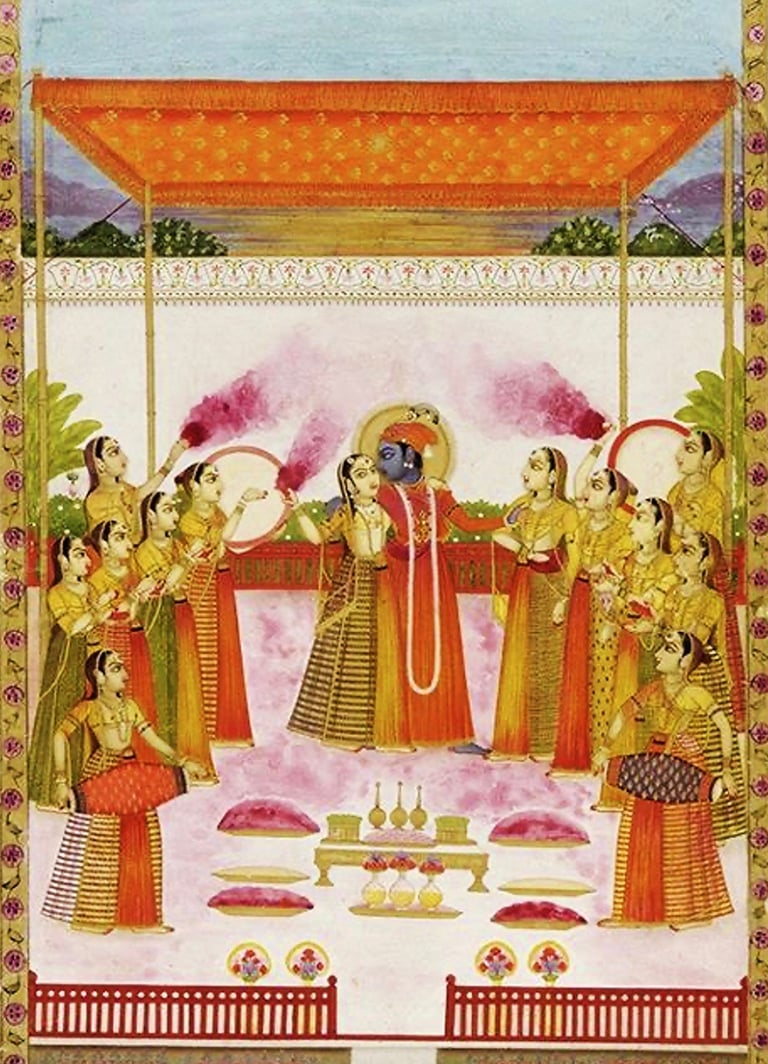

Holi Festival
by: B.G. Sharma
2. Another sacred branch on the family tree is the great Vaishnava (vie-sh-nov) Sri Narottam das Thakura (na-row-tom DOS TA-coor). He also took shelter in Vrindavan where he and Shrinivas became great friends. The entire story of Narottam’s life is breathtaking to read. Here is short story that took place in Vrindavan, India, where Lord Krishna appeared 5000 years ago.
“As the days passed into weeks and then months, Narottam grew in spiritual accomplishments, as did his reputation throughout Vrindavan (vrin-DA-von). One night, a divine Vaishnavi (cowherd girl) appeared to him in a dream and said, “Dedicate yourself to the feet of your guru and do whatever he asks. Your sincerity and austerity have pleased me, and I will see that you are engaged in a very confidential service. When I meet Krishna every afternoon, I see that the (devotees) are serving Him with the utmost care. They make a special milk-based preparation for Him, and Champakalata is the most efficient gopi in this service. You shall work under her direction boiling the milk and remember that I become happy if Krishna is happy.”
“When Narottam awoke, he quickly ran to his spiritual master, Lokanath Goswami, and conveyed the entire dream. He embraced Narottam, confirming that the Vaishnavi was indeed Radhika, Krishna’s eternal companion (Radha). Lokanath was pleased to hear that Narottam was given a special service: boiling milk, by Radharani, Herself. Lokanath understood that this was his disciple’s eternal service to Krishna, and that Radhika was merely reinstating him in that service.
“After being given this unique chore by Radharani and having it confirmed by his guru, Narottam would sometimes go into elaborate meditative trances, visualizing himself boiling milk for Radhika and the gopis, while in his eternal spiritual form.
“In this (perfected spiritual form) he used dry wood for the fire, which kept the milk boiling. On occasion, however, the milk would overflow. Whenever this happened, Narottam would try to stop the overflowing milk with his bare hands. During his intense meditations, he would often neglect the fact that his hands were scorched. But when his contemplation subsided, he saw that the scorched hands in his mystical vision had accompanied him back to the world of three dimensions. Sometimes he tried to cover his hands with a piece of cloth, but all of Vrindavan knew the transcendental way in which he had received the burns.” (THE LIVES OF THE VAISHNAVA SAINTS: SHRINIVAS ACHARYA, NAROTTAM DAS THAKURA, SHYAMANDA PANDIT, by Steven J. Rosen, page 84, Folk Books, 1991)
*** ** ***
3. Also devoted to Lord Chaitanya, His Holiness Gopal Bhatta Goswami (go-PAULbot-ta go-SWA-ME) is another great spiritual master, wonderfully decorating Shrila Prabhupada’s family tree.
“Living his life as an embodiment of the Scriptures, his fame spread throughout all of India and he became known as the younger brother of Rupa and Sanatan (Lord Chaitanya’s two chief disciples).
“In Vrindavana, Gopal Bhatta Goswami’s reputation as a master in the process of Bhakti Yoga (loving devotional service) became especially prominent after a trip to the Gandaki River in Nepal.
There, he procured twelve sacred stones (Shilas) that are considered special incarnations of Krishna and he brought them back to Vrindavan.
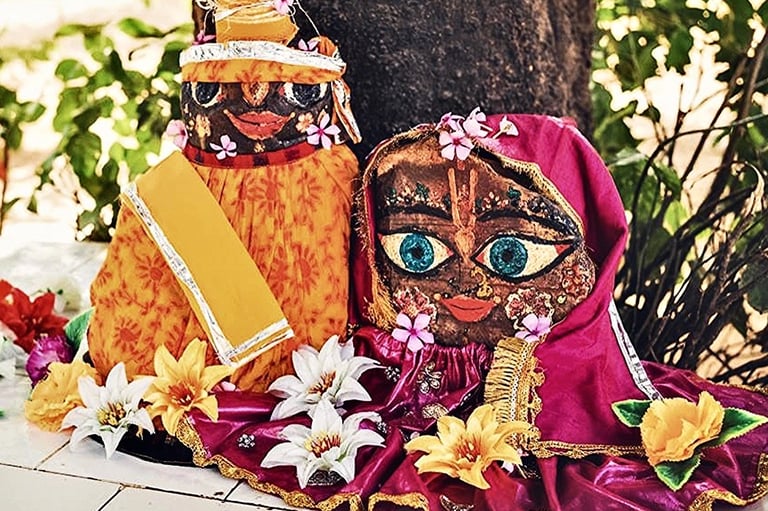

Shilas
Sacred Stones
The trip to Nepal and back was arduous, as in those days it meant traveling by foot, but Gopal Bhatta was undaunted. Upon arriving back in Vrindavan, however, he felt unqualified to worship his sacred stones. And so he again journeyed back to the Gandaki in Nepal. He felt he should return them back to the river.
“Carefully placing the stones in the holy river while chanting the appropriate prayers, the sacred stones spontaneously jumped back into his hands. Trying three or four times to leave them in the river, he found that he was not able to do so, for the same mystical phenomenon occurred again and again. He took this as a sign from Lord Krishna that he was to take them back to Vrindavan and worship them. This he did, and he soon became known in Vrindavan as the Goswami who worshiped twelve unique Shilas (SHE-luh-s). He carried them at all times in a cloth bag that hung from his neck.
“In 1542, eight years after the disappearance of Lord Chaitanya, Gopal Bhatta felt the need to worship a Deity (a statue-like form of Krishna).
“This need became especially poignant when a wealthy merchant gave him jewelry, ornaments, and fine cloth for the worship of the Lord. Because Shilas (sacred stones) do not have a human-like form, Gopal Bhatta considered that these ornaments could not be properly used in Their worship. Therefore, he placed all these items before his Shilas and fervently prayed for proper guidance which, however, on that particular evening was not granted.
“The next morning, however, he found that one of the Shilas, known as the Damodhara (DA-mow-dar Shila), had transformed into an incomparably beautiful Deity of Krishna, just as he had desired. Overcome with happiness, he fell to the ground in all humility and began to offer humble prayers and profound eulogies. Hearing of the miraculous event, many senior devotees hurried to the sacred spot where Gopal Bhatta was offering salutations of love. They were all there when he named the Deity: Shri Radharaman.
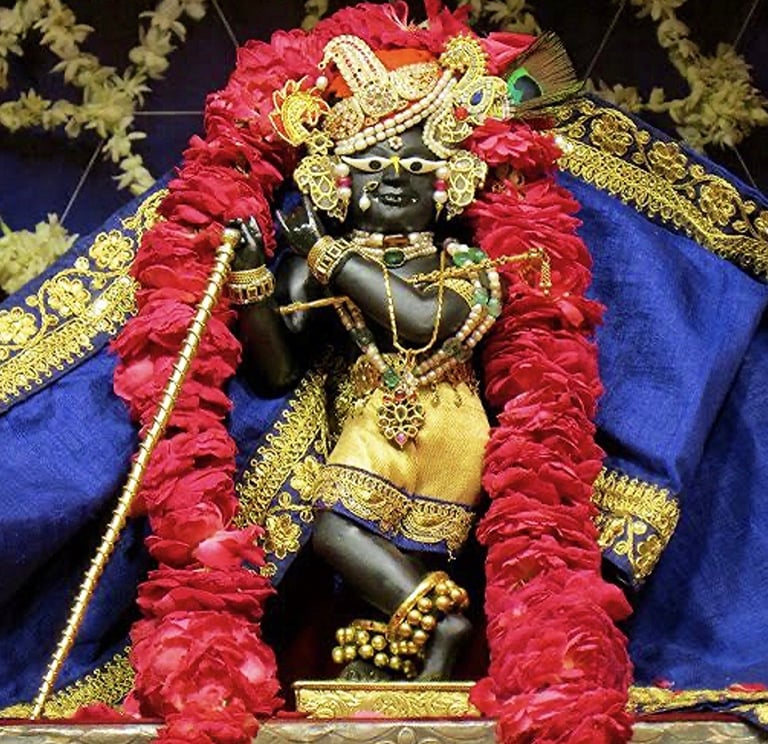

Shri Radharaman
Photo by: Shri Radha Raman Ji Mandir
This Deity is worshiped in the same place today: Vrindavan, India.” You are welcome to visit Vrindavana and see Gopal Bhatta’s Deity for yourself. (THE SIX GOSWAMIS OF VRINDAVAN, by Steven Rosen, p. 75, Folk Books, 1990.)
On this topic of “sacred stones,” I must admit that when I first heard about them I was more than a bit doubtful. However, I find it even more remarkable to have discovered that “living stones” are not just some exclusive phenomenon, belonging to some far out Hindu cult. In his fascinating book, Om Shalom, Judaism and Krishna Consciousness, there is a particular conversation between its author, Mr. Steven Rosen, and Rabbi Jacob N. Shimmel, who is a noted Jewish scholar. In this book, Rabbi Shimmel explains how there is an entire section of the Kabbalah which deals with reincarnation. This section is called Sefer HaGilgulim and mentions, of all things, divine life in “certain kind of stones.”
*** ** ***
Finally, this book would not be complete without mentioning the wonderful life of Haridasa Thakura (har-ee-dos TA-koor) who was a great devotee whom Lord Chaitanya (chay-ton-ya: the founder of the Hare Krishna movement) ordained as the final authority regarding the Holy Name of the Lord. Although reading what follows will take you a few extra minutes, I have included it because the associated blessing you will receive by hearing about him will change your life. We are our blessings!
“Although no one can describe all the qualities of Haridasa, one may say something about them just to purify himself.” (CHAITANYA-CHARITAMRITA, Antya-lila 3.97: These pastimes of Haridasa Thakura were recorded during a live, eight-day lecture series, given by His Holiness Varshana Swami. Varshana Swami is a much-loved and respected sannyasi (celibate priest). Quotes are taken from these lectures. Quotes are also taken from the tenth canto of the SHRIMAD-BHAGAVATAM, chapter 13; also, CHAITANYA-CHARITAMRITA, Antya-lila, Ch’s 9-11.)
In order to thoroughly appreciate the exact identity of Haridasa Thakura, we need to go back in time, about 5000 years, to the extraordinary childhood activities of Lord Krishna. During this divine lila (pastime), the Lord was living in Vrindavan, playing as an ordinary child would; as a young cowherd boy in rural India. Surrounded by many of His eternal associates from the Spiritual World, Lord Krishna enjoyed many thrilling adventures.
Both as a baby and a cowherd boy, the Lord was involved in many miraculous events, such as killing great demons who had sought to destroy Him; turning a basket of fruit into a basket of jewels, and uprooting two large trees. These and many more childhood pastimes of Lord Krishna have been translated for us by Shrila Prabhupada, specifically in the tenth canto of the Shrimad-Bhagavatam (SHREE-mod-BHA-ga-va-tom). These descriptions are also found in his summary of the tenth canto which has been published in three volumes: "Krishna, The Supreme Personality of Godhead."
It was during the childhood of Lord Krishna that Brahma (bra-ma), the appointed creator of this universe, wanted to test Krishna to see if He was truly God. Brahma had become quite puffed-up; very proud of his exalted position. His false pride was preventing him from understanding the Lord’s true identity, as the Supreme Personality of Godhead.
The custom at that time was for the young boys of Vrindavan to gather their calves each day, leading them out to pasture. Each cowherd boy carried his lunch with him. Having left early one morning with all the calves, because it was getting late and having come upon the perfect place to rest, Krishna suggested that they should eat their lunch, letting the calves “go slowly here and there.”
While Lord Krishna and the boys were eating, “the calves went far away, deep into the forest, being allured by green grass.” Because the cowherd boys could no longer see the calves, they became frightened. In order to mitigate the worries of this friends, the Lord said, “My dear friends, do not stop eating. I shall bring your calves back to this spot by personally going after them, Myself.”
Leaving the company of His friends, “Carrying His yogurt and rice in His hand, the Supreme Personality of Godhead, Krishna, immediately went out to search for the calves. To please His friends, He began searching in all the mountains, caves, bushes and narrow passages.”
Taking advantage of this opportunity, Brahma, who wanted to display his own supernatural powers and trick Krishna, carried the boys and their calves to a remote place, putting them asleep with his mystic powers. Because of the metaphysical nature of Brahma and what he had done, although, for him, hiding the boys and their calves only took a few minutes, on earth an entire year passed by.
When Lord Krishna was unable to find either the calves or His friends, and seeing how it was time to return to the village, sensing some trickery on the part of Brahma, the Lord simply expanded Himself; simultaneously turning Himself “into the exact number of missing cowherd boys and calves, with their exact bodily features, their particular types of hands, legs, and other limbs; their sticks, bugles and flutes, their lunch bags, their particular types of dress and ornaments placed in various ways, their names, ages and forms, and their special activities and characteristics.”
Lord Krishna also “expanded Himself so as to appear as the calves.” In this way, as if nothing was wrong, Lord Krishna, the cowherd boys and their calves, entered Vrindavan, greeted by their mothers with great love. For one entire year, the Lord continued to play with His friends and calves, just as before. If anything, the boys were loved even more by their parents, just as the cows were feeling greater affection for their calves, since everyone was really a direct expansion of the most lovable person of all: Lord Krishna.
Meanwhile, Brahma returned to see Krishna’s bewilderment, thinking that Krishna would not be able to find the calves and cowherd boys. Instead, what Brahma saw was that “Lord Krishna was engaged just as before, playing with the boys and calves, who were His expansions.” It was now Brahma who became bewildered, unable to know for certain “who was real and who was not real.” Brahma became completely mystified.
Then, while Brahma was watching, all of the calves and cowherd boys each assumed the Lord’s personal form, separately dressed in yellow-silken garments. “Then, by the power of those Vishnu-murtis (vish-noo moor-tees: Godly forms), Brahma, his senses jolted by astonishment and stunned by transcendental bliss, became silent, just like a child’s clay doll in the presence of the village deity.
“Brahma’s external consciousness then revived, and he stood up, just like a dead man coming back to life. Opening his eyes with great difficulty he saw the universe along with himself. Then, looking in all directions, Brahma immediately saw Vrindavan before him, filled with trees. Then he saw the Absolute Truth, assuming the role of a child in a family of cowherd men and standing all alone, just as before, with a morsel of food in His hand, searching everywhere for the calves and His cowherd friends. After seeing this, Brahma hastily got down from his swan carrier, fell down like a golden rod and touched the lotus-feet of Lord Krishna. Then, rising very gradually and wiping his two eyes, Brahma looked up at Krishna.”
After this incident, after Brahma had returned to his own abode, Brahma’s mind was deeply disturbed. He couldn’t escape his shame. He could now understand that his false pride had clouded his vision, preventing him from acting properly before his beloved Lord. This had robbed him of the greatest opportunity: to be part of the loving pastimes of Lord Krishna in Vrindavan. Others had participated, but not him. Never wanting to make this mistake again, Brahma made a vow that the next time Lord Krishna would appear on earth, he would not be left out.
Still upset with himself, Brahma returned to earth once more, sitting down upon the very island that Lord Krishna would appear on—some 5000 years later—as Lord Chaitanya (chay-ton-ya). In a very secluded place, without food or sleep, Brahma undertook great austerities to sanctify his vow before God.
Described in the Holy Scriptures, in response to Brahma’s sincere prayers, Lord Krishna appeared before His devoted servant, giving him a glimpse into the future. The Lord appeared as brilliant as the golden sun, with beautiful lotus-like eyes and long, graceful arms.
Seeing the incredible beauty of Lord Chaitanya, Brahma fainted in ecstasy. Then, with folded palms, he asked Lord Chaitanya for the benediction that he would become one of His disciple during His next incarnation, to help rid him of the horrible pride that had led to his shameful conduct in the first place.
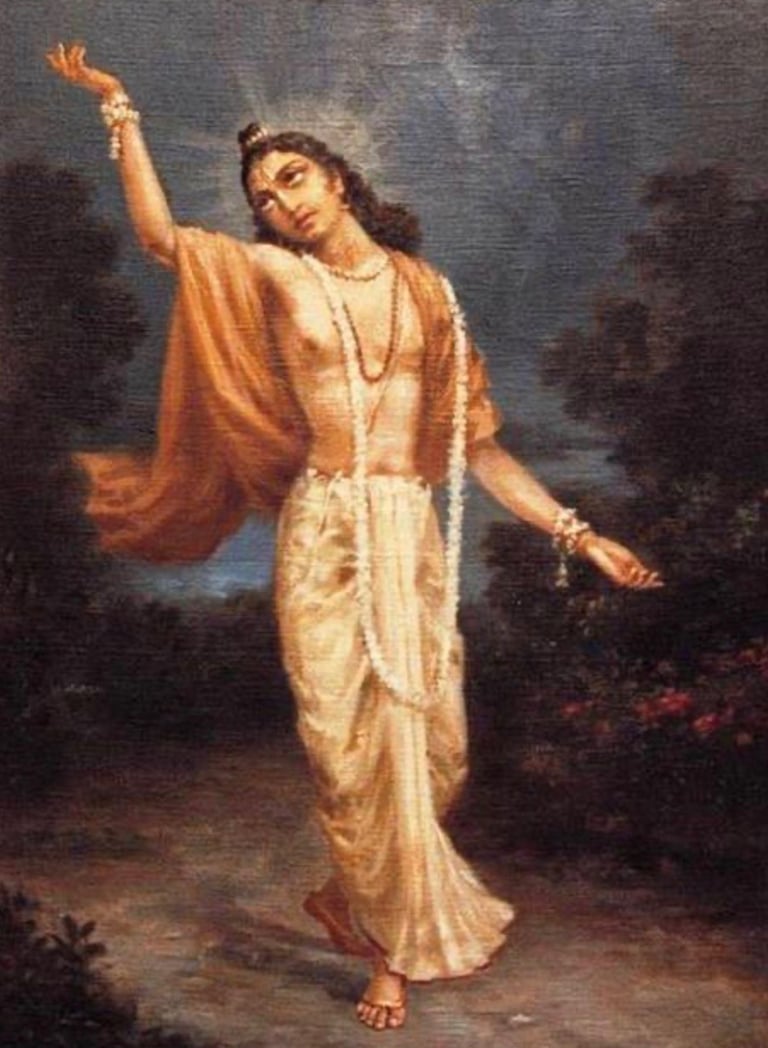

Lord Chaitanya Mahaprabhu
Smiling, Lord Chaitanya immediately promised Brahma that, yes, he would take part in His next appearance on earth. “To grant you your wish and to help you overcome your pride, you shall take birth within a Muslim family,” (which according to the tradition of orthodox India would be considered a very low birth, indeed). “You shall rise up to become a great devotee of Mine, famous for chanting 300,000 names of God everyday. When you grow old and are about to die, you will see Me face to face, thus attaining My spiritual abode.” In this way, the Lord revealed to Brahma many secrets of His next incarnation.
Although chanting the Lord’s Holy Name is the best process for spiritual upliftment in all yugas (ages), in Kali-yuga, the most degraded of the four yugas and the period in which the earth has now entered, the chanting of the Holy Name is the only means of redemption.
Lord Chaitanya personally established that whoever is convinced that all perfection is obtained by chanting the Lord’s Holy Name, that he alone is the topmost practitioner of devotional service. Being thus blessed, Lord Brahma would later take his birth as Haridasa Thakura and become that topmost person.
In time, Lord Chaitanya would ordain Haridasa as the prime authority on the art of chanting the Holy Name. His very life would become the perfect example of both the preaching and practice of chanting “Hare Krishna.” Haridasa would teach that the loud chanting of the Lord’s Name is simultaneously the most perfect and most sublime means for attaining one’s heart’s desire, as well as the sacred goal of devotion, itself. Therefore, the life and teachings of Haridasa Thakura were praised by Lord Chaitanya.
*** ** ***
Now let us go back in time. The date is approximately thirty years before the birth of Lord Chaitanya (1456); a dark passage in India’s long history when she was being ruled by a horde of Muslim conquerors. Naturally, great animosity existed between these two, very opposite cultures. It was during these tense and difficult years that the young Haridasa began his rise to fame.
Because Haridasa was a Muslim and because he had adopted the Hindu practice of chanting the Holy Names of Krishna, the chief magistrate, Ramachandra Khand (RA-ma-chon-dra kon), had become especially hateful toward Haridasa. At the time, Haridasa was living in a forest hut as a recluse, chanting his 300,000 names of Krishna everyday, along with worshiping the holy Tulasi (TOLL-see) tree.
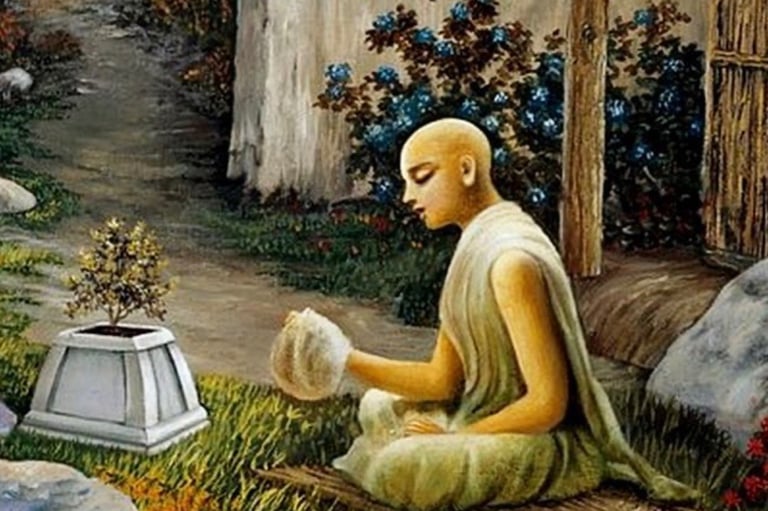

Haridas Chanting and Worshiping Tulasi
© BBT
When he felt the necessity to eat, he would simply beg a little food from the local villagers. In this way, the reputation of Haridasa Thakura spread far and wide. The villagers loved and respected this gentle soul very much.
Unable to tolerate any admiration shown toward Haridasa by the local hindus, the magistrate began to plot an evil trap to seal the fate of this Muslim traitor. Employing the help of local prostitutes, an especially beautiful young girl was sent to Haridasa’s hut to entice him into having sex with her. The plan was to arrest Haridasa after his second encounter with the girl, so as to have irrefutable evidence against him. Of course, this meant that the young prostitute would have to be successful at least once before the soldiers would arrest him. Upon seeing the girl’s exquisite beauty, the magistrate knew that no man could resist her invitations. The heinous trap was thus set.
The forest in which Haridasa sat was enchanting. Cool breezes lifted exotic perfumes from the wild flowers which grew there, filling the evening air with an intoxicating smell. Haridasa sat on the ground, just outside his hut, gazing at his beloved Tulasi tree that he adored very much. Immersed in chanting the great prayer of deliverance (Hare Krishna Hare Krishna Krishna Krishna Hare Hare Hare Rama Hare Rama Rama Rama Hare Hare), the prostitute suddenly appeared as if she had been carried there upon the evening breeze. After she offered her obeisances to the Tulasi tree, the young prostitute slowly began to reveal to Haridasa various parts of her naked body, exclaiming that she had come to give herself in union with him.
Hearing her thus speak, Haridasa told her to please sit down and that as soon as he finished his chanting, he would immediately satisfy her. He told her that until he completed his daily vow of chanting 300,000 names of God, he could not do anything else. But, he assured her, he would finish as soon as possible.
Throughout the night Haridasa chanted, with the prostitute listening. At times she chanted the Names of God with him. When dawn arrived, the prostitute got up to leave, telling Haridasa that she would come back that evening. Haridasa again assured her—next time, without fail, he would completely satisfy her .
As promised, once again the beautiful young girl approached Haridasa, first stopping to pay her obeisances to the sacred Tulasi tree, and just as before, Haridasa told her that as soon as he finished his required chanting, he would come to her. The prostitute then sat and listened to the prayers, and again, at times, chanted with him.
However, the morning light repeated the disappointment of the previous day. Undeterred, she got up to leave, promising to come back a third time. Each time she had to tell the evil magistrate that one more night was required for the trap to work.
It was on that third night that something very remarkable happened. Arriving, the prostitute paid her obeisances to Tulasi. Again she sat in a revealing position. But on that night, as she heard the Lord’s Holy Names being chanted by His topmost devotee, the prostitute’s heart suddenly changed. She covered herself and fell at the feet of Haridasa, confessing everything: the plot, the trap that the magistrate had set in motion, and now her deep shame.
After she spoke, Haridasa told the young girl that he already knew about the magistrate and his sinister trap, and that he had been prepared to leave days ago, but because he knew that she would be coming, he had stayed longer, just to deliver her.
Following the instructions of Haridasa, the girl gave away her worldly possessions and moved into the forest hut. Alone, she took care of Haridasa’s Tulasi tree and began, herself, chanting 300,000 names of God everyday. In fact, as time went by, she became a famous teacher of the Holy Name, guiding many souls on this great path of salvation.
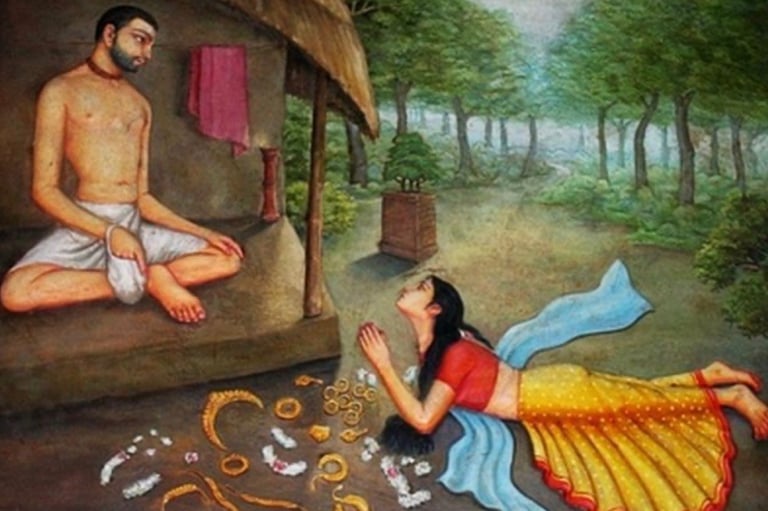

The Prostitute’s Confession
© BBT
This instructive episode in the life of Haridasa Thakura illustrates how the Holy Name has the power to reclaim even the worst of sinners. Similar stories are also told by Helen Bacovcin in The Way of a Pilgrim, dramatically showing the power of chanting the Holy Name of Christ.
Because of Haridasa’s Muslim birth, he had to undergo many trials during his lifetime. On another occasion, again brought about by his popularity amongst the local villagers, a much greater villain threatened his life. Haridasa was seen by this Muslim ruler as a great insult to the Holy Koran. To see Haridasa (a Muslim) attracting so many Hindu followers was something that could not be tolerated.
The Mohammedan ruler went to the Muslim King and arranged for soldiers to arrest Haridasa. Thrown into prison, Haridasa was given an ultimatum. If he agreed to renounce the chanting of Lord Krishna’s Holy Names and take up the Koran with his heart and soul, only then would Haridasa’s life be spared. Otherwise, Haridasa was assured that an example would be made of him to convince any other would-be Muslim converts that conversion to Hinduism would not be tolerated.
Hearing the ultimatum, Haridasa felt no fear and the king was astonished by his composure. But, still, the king wanted to know why Haridasa, a Muslim, was stooping so low as to chant the Names of a so-called Hindu God.
Haridasa then spoke to the king and his ministers, telling them that he was a servant of God and that whatever the Lord’s Will for him was that he was ready to accept it fully. He told them that even if they tortured him, or cut his body into little pieces he would never give up chanting the Holy Names of Lord Krishna. “Even if you inflict suffering upon me which knows no end, I shall never deviate from chanting Hare Krishna.”
The Mohammedan ruler was furious. He told the king that Haridasa’s sin was so great that no amount of atonement would erase his guilt. Only public execution (a very brutal and violent death) was fitting for the likes of Haridasa Thakura.
Now the king had no choice. The executioner was summoned along with his many assistants. They were men of no mercy. Quickly they bound Haridasa tightly. He was then condemned to death by public caning; to be carried out immediately in the public markets for all to see. Although there were twenty-two marketplaces, even the most robust prisoner seldom survived beyond the third beating.
What happened next was a miracle. The beatings not only continued through the first three marketplaces, but all twenty-two markets! Exhausted, his executioners then began to panic, knowing very well that unless Haridasa was killed according to the instructions of the king, that they, too, would be subject to severe punishment. Pleading with Haridasa to die, he agreed to their appeal. Entering into a spiritual trance, all symptoms of life left his body.
Much relieved, the executioners took Haridasa’s limp body back to the king’s castle. The king wanted to give Haridasa a proper burial but the Mohammedan ruler insisted otherwise. He said that any funeral would only honor Haridasa, who deserved only dishonor. Therefore, the executioners were ordered to throw the body of Haridasa into the river so that his soul would never know any peace.
As the men placed Haridasa’s corpse by the river, suddenly Haridasa sat up, as his spiritual trance broke. Now the men became even more terrified for their lives. Again they begged Haridasa to die. Taking pity on his executioners, Haridasa told them to throw his body into the swift Ganges where he would surely drown.
Protected by this sacred river, who always provides shelter for the Lord’s humble devotees, far from all to see, Haridasa washed up on her banks, unseen except for one person, the king, who at the time was out riding his horse. Immediately the king dismounted and fell before Haridasa, begging for forgiveness. “You are everything that the people say you are.” The king then gave Haridasa permission to stay in his kingdom forever and to worship God however he saw fit.
While it is true that Haridasa Thakura never condemned his attackers, only forgiving them, we need to jump twenty years in time to fully appreciate the purport of this amazing story. We need to hear how one day Lord Chaitanya motioned for Haridasa to approach Him: “Over here Haridasa.”
The Lord spoke up so that everyone present could hear. “I want you to know, Haridasa, that My advent (upon the earth) was hastened by the beating you once took. I had to come because I could not tolerate your suffering. I was ready to destroy everyone, but when I found that you were praying for your punisher’s deliverance, I was controlled by your love. So I did the only thing I could. Standing over you, I took the beating, Myself.” Rising, Lord Chaitanya turned around so that everyone could see His back. Seeing the deep scars, everyone gasped. Haridasa fainted.
After Haridasa regained consciousness, Lord Chaitanya gave the benediction that anyone who gets Haridasa’s association, "or even hears about Haridasa Thakura," will attain the shelter of Lord Krishna.
There are many other stories about Haridasa Thakura: how he lived in a cave with a venomous snake; how the Lord’s divine energy assumed the form of a goddess and tested him again, in the same way that the young prostitute had. There is also a story of how a sacred twig, planted by Lord Chaitanya in front of Haridasa, immediately grew into a large shade tree, simply for Haridasa’s comfort. Eventually the final hours of Haridasa Thakura’s life arrived. Hearing how he died is how we shall end this narration.
One day, Govinda, the personal servant of Lord Chaitanya, went to deliver the remnants of Lord Jagannatha’s (jog-a-nath) food to Haridasa Thakura (Lord Jagannatha is the wooden form of the Lord, located in an ancient temple). When Govinda came to Haridasa, he saw that Haridasa was lying on his back and chanting his rounds very slowly.
“Please rise and take your (lunch),” Chaitanya said.
Haridasa replied, “Today I shall observe fasting. I have not finished chanting my regular number of rounds. How can I eat?”
The next day, Lord Chaitanya went to Haridasa’s place and inquired from him, “Haridasa, are you well?”
Haridasa offered his obeisances to the Lord and replied, “My disease is that I cannot complete my appointed rounds.”
“Now that you have become old,” the Lord said, “you may reduce the number of rounds you chant daily. You are already liberated, so therefore you need not follow the regulative principles very strictly. Your role in this incarnation was to deliver the people in general. You have sufficiently preached the glories of the Holy Name in this world. Now, therefore, please reduce the fixed number of times you chant Hare Krishna.”
Haridasa replied, “Kindly hear my real plea. I was born in an inferior family, and my body is most abominable. I have engaged in low work. Therefore, I am the lowest, most condemned of men. I am un-seeable and untouchable, but You have accepted me as Your servant. This means that You have delivered me from a hellish condition and raised me to the topmost spiritual platform.
“My dear Lord, You are the fully independent Personality of Godhead. You act by Your own free will. You cause the whole world to dance and act as You like. By Your mercy, You have made me dance in many ways.
“I have had one desire for a very long time. I think that quite soon, my Lord, You will bring to a close Your pastimes within the material world. I wish that You not show me this closing chapter of Your pastimes. Before that time comes, kindly let my body fall down in Your presence. I wish to catch Your lotus-like feet upon my heart and see Your moon-like face with my eyes. With my tongue I shall chant Your Holy Name (Shri Krishna Chaitanya). That is my desire. Kindly let me give up my body in this way.”
The next morning, after visiting the temple, Lord Chaitanya, accompanied by His disciples, came to see Haridas, who immediately offered his respects to Lord Chaitanya, his life and soul. Haridasa then offered his respects to the assembled devotees.
Lord Chaitanya immediately began singing and dancing in the courtyard. All the devotees surrounded Haridasa and began congregational chanting. In front of all the great devotees, Lord Chaitanya began to describe the holy attributes of Haridasa Thakura. As He described the transcendental attributes of Haridasa, Lord Chaitanya seemed to possess five mouths. The more He described, the more His happiness increased.
After hearing of the transcendental qualities of Haridasa, all the devotees present were struck with wonder. They offered their respectful obeisances to the lotus-feet of Haridasa Thakura.
Haridasa made Lord Chaitanya sit down in front of him and then fixed his eyes, like two bumblebees, on the lotus-face of the Lord. He held the lotus-feet of the Lord on his heart and then took the dust from the feet of all the devotees present, and put it on his head. He began to chant the Holy Name of Lord Chaitanya again and again. As he drank the sweetness of the Lord’s divine face, tears constantly glided down from his eyes. While chanting the Holy Name of Lord Chaitanya, he gave up his life air and left his body. Seeing the wonderful death of Haridasa by his own will, everyone remembered the passing away of Bhisma. (Note: Bishma had been given the benediction of not having to die until he chose to do so. The story of this mighty warrior is narrated in the great Indian classic, the Mahabharata.)
There was a tumultuous noise as they all chanted the Holy Names, ‘Hari’ and ‘Krishna.’ Lord Chaitanya became overwhelmed with ecstatic love. Because of His ecstatic love, all the devotees were helpless, and in ecstatic love they also began to dance and chant congregationally.
Lord Chaitanya danced for some time (carrying the body of Haridasa). Then the Lord was informed of other burial rituals for the body of Haridasa Thakura.
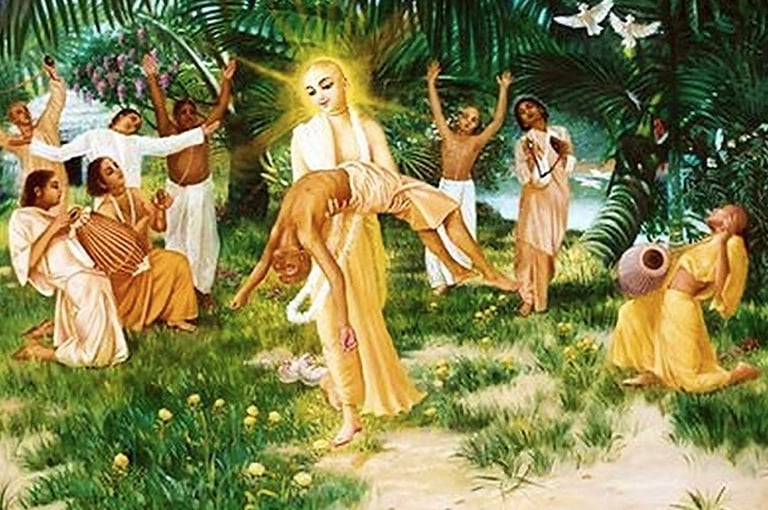

Lord Chaitanya carries the lifeless body of His beloved devotee, Haridas Thakura
The body of Haridasa was raised onto a carrier that resembled an airship and taken to the sea, accompanied by congregational chanting. Lord Chaitanya bathed the body of Haridasa in the sea and then declared, “From this day on, this sea has become a great pilgrimage site” (the Bay of Bengal).
Everyone drank the water that had touched the lotus-feet of Haridasa, and then they smeared remnants of the Deity’s sandalwood pulp over Haridasa’s body. After a hole was dug in the sand, the body of Haridasa Thakura was placed in it. Other remnants from the temple Deity, such as His silken ropes, sandalwood pulp, food and cloth, were placed on the body. All around the body, the devotees performed congregational chanting, and Vakreshvara Pandita danced in jubilation. With His transcendental hands, Lord Chaitanya personally covered the body of Haridasa with sand, chanting ‘Hari bol, Hari bol! (Chant the Holy Name of God).
Later that day, Lord Chaitanya presided over a great feast to honor Haridasa Thakura. Overwhelmed with ecstatic love, Lord Chaitanya offered a benediction to all the devotees, which they heard with great satisfaction. The Lord gave this benediction: “Anyone who has seen the festival of Haridasa Thakura’s passing away, anyone who has chanted and danced here, anyone who has offered sand on the body of Haridasa, and anyone who has joined this festival to partake of (this feast) will achieve the favor of Krishna very soon. Haridasa was the crown jewel on the head of this world; without him, this world is now bereft of its valuable jewel. Say, All glories to Haridasa Thakura and chant the Holy Name of Hari.”
Everyone began to chant: “All glories to Haridasa Thakura, who revealed the importance of chanting the Holy Name of the Lord.”
Thereafter, Chaitanya Mahaprabhu bid farewell to all the devotees, and He Himself, with mixed feeling of happiness and distress, took rest. (CHAITANYA-CHARITAMRITA, A.C. Bhaktivedanta Swami Prabhupada, Antya-lila, 11:16-100)
*** ** ***
To end this section about Haridasa Thakura, perhaps it is best to quote directly from the (CHAITANYA-CHARITAMRITA, Adi-lila, 9:2-26 & 10:43,45).
“All glories to Lord Chaitanya. All glories to the devotees of Lord Chaitanya. I take shelter of the Supreme Personality of Godhead Shri Chaitanya Mahaprabhu, who Himself is the tree of transcendental love of Krishna. He is the desire tree of devotional service. (He) became the main trunk of the tree of devotional service. From the trunk grew many branches and above them innumerable others. Thus the branches of the Chaitanya tree formed a cluster or society, with great branches covering all the universe. Since Lord Chaitanya was the original trunk, the taste of the fruits that grew on the branches and sub-branches surpassed the taste of nectar.”
“I offer my obeisances to all the dear devotees of Chaitanya Mahaprabhu, the eternal tree of love of Godhead. I offer my respects to all the branches of the tree: the devotees of the Lord who distribute the fruit of love of Krishna. The twentieth branch of the Chaitanya tree was Haridasa Thakura. His character was wonderful. He used to chant the Holy Name of Krishna 300,000 times a day without fail. There was no end to the transcendental qualities of Haridasa Thakura. He did not even slightly raise an eyebrow when persecuted by the Mohammedan ruler.”
*** ** ***
Let us now continue with our inquiry into the spiritual master’s “inner-man,” continuing with our attempt to better appreciate his unique position.
From the Scriptures we can understand that the spiritual master is being called upon to help humanity; a holy assignment encouraged by the deep sorrow felt within his own heart for the tragic suffering of mankind. Honestly, if we were to somehow feel this suffering (even for a split second), I fear we would explode.
In his lectures, Shrila Prabhupada spoke often about this deep-seated compassion, echoing the same compassion spoken in this prayer: “I offer my respectful obeisances unto all the devotees of the Lord. They are just like ‘desire-trees’ who can fulfill the desires of everyone, and they are full of compassion for the fallen conditioned souls.”
Again, we are trying to appreciate the spiritual master’s “inner person,” just as we considered the character of our bicycle mechanic. Hundreds of years ago a great devotee poured his heart out to Lord Chaitanya, helping to give us the understanding we need. His name was Vasudeva Datta, and he spoke as follows: “My Lord, my heart breaks to see the suffering of all conditioned souls; therefore I request You to transfer the karma (reaction) of their sinful lives upon my head. My dear Lord, let me suffer perpetually in a hellish condition, accepting all the sinful reactions of all living entities. Please finish their diseased (suffering) material life.” (CHAITANYA-CHARITAMRITA, A.C. Bhaktivedanta Swami Prabhupada, Madhya-lila 15:162-63)
Shrila Prabhupada has taught that a devotee’s main qualification is that he is made unhappy by seeing others unhappy. Shrila Prabhupada said, “Lord Chaitanya is God Himself. He comes down to preach (to us) to become a (preacher), and to take so much trouble all over India and everywhere, and giving instructions and sending men. ‘Go, go, go.’ What? He is perfect. Why He’s coming? He doesn’t require (need to come). No. For the benefit of others, we must follow the footsteps of Lord Chaitanya. The real business of a Vaishnava (devotee) is not for himself but for others.” (CONVERSATIONS WITH SHRILA PRABHUPADA, A.C. Bhaktivedanta Swami Prabhupada, Vol. 6, pp. 118, 212, © BBT-Int’l, 1989)
It is also necessary to say something about the spiritual master’s deep commitment: the driving force that sets the standard for all his activities. Of course, his allegiance to God is paramount. However, equally distinct, we discover within him his deep love for his own spiritual teacher. Therefore, every morning the spiritual master prays:
The lotus-feet of our spiritual master are the only way which we can attain pure devotional service. I bow to his lotus-feet with great awe and reverence. By his grace one can cross the ocean of material suffering and obtain the mercy of Krishna.
My only wish is to have my consciousness purified by the words emanating from his lotus-mouth. Attachment to his lotus-feet is the perfection that fulfills all desires.
He opens my darkened eyes and fills my heart with transcendental knowledge. He is my Lord birth after birth. From him ecstatic prema (pray-ma: love of God) emanates; by him ignorance is destroyed. The Vedic Scriptures sing of his character.
Our spiritual master is the ocean of mercy, the friend of the poor, and the lord and master of the devotees. 0 master, be merciful unto us. Give us the shade of your lotus-feet. Your fame is spread all over the three worlds.
I was born in the darkest of ignorance, and my spiritual master opened my eyes with the torch of knowledge. I offer my respectful obeisances unto him.
These famous prayers reveal why the spiritual master “recognizes as his highest objective the desire for carrying with veneration the shoes of the order of the Paramahamsas.” (pa-ra-ma-hon-sa-s: previous pure devotees). (CONVERSATIONS WITH SHRILA PRABHUPADA, Vol.6, p.123.)
As we are learning, the spiritual master also has a spiritual master—even as Lord Krishna did when He appeared here on earth 5000 years ago Also, Lord Chaitanya accepted Ishvara Puri (eesh-va·ra poor-ee) as His spiritual master. “One may ask that if Chaitanya is Krishna Himself, then why did He need a spiritual master? Of course, He did not need a spiritual master. But because He was playing the role of acharya (a-CHAR-ya: one who teaches by example), He accepted a spiritual master. Even Lord Krishna accepted a spiritual master, for that is the system. In this way the Lord sets the example for mankind.” (CHAITANYA CHARITAMRITA, Introduction.)
MARK 1:9:“Then one day Jesus came from Nazareth in Galilee, and was baptized by John (the Baptist) there in the Jordan River.”
SAINT NICEPHORUS: “It is necessary to look for a spiritual director.”
THE PILGRIM:“I read the Bible and asked for the whereabouts of a spiritual teacher.”
Referring to his own spiritual master (Shrila Bhaktisiddhanta Sarasvati Thakura), Shrila Prabhupada mentioned that, “On the very first meeting with His Divine Grace, he asked me to preach the message of Lord Chaitanya in the Western world. By the causeless mercy of my Divine Master, the order of preaching was impressed on my heart.”
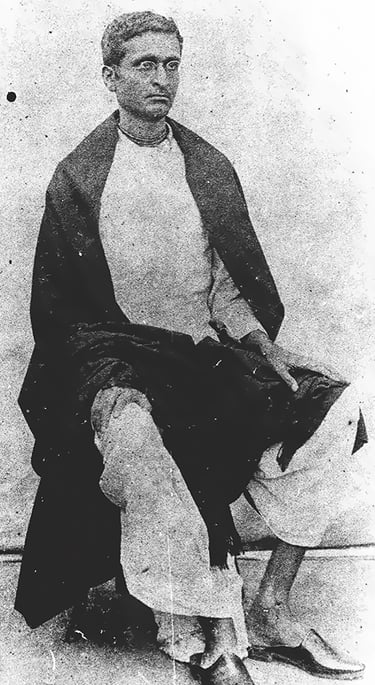

Shrila Bhaktisiddhanta Sarasvati Thakura
The Spiritual Master of Shrila Prabhupada
A.C. Bhaktivedanta said, “My Guru Maharaja had an ambition to publish the message of Lord Chaitanya in all the languages of the world. (Therefore) the organization of press and literature and public sales should be our main business.”
Elsewhere, Shrila Prabhupada mentions that “Lord Chaitanya taught us; even the most intimate disciples of Lord Chaitanya, they were sent: ‘Go and preach. Go door-to-door. Teach them (the chanting of) Hare Krishna.’ So our mission is like that: we go door-to-door, to connect them, to be linked-up with this movement. Whomever you meet, just deliver the instruction of Krishna to him. That’s all. This is Lord Chaitanya’s mission. This is our movement, simply how to make people pure, moral, sinless, and advanced in God consciousness. Let us try to make them Krishna conscious. That is our only interest. Because I love Krishna, I want to see all, everybody in the world become Krishna conscious (to love Krishna).” (CONVERSATIONS WITH SHRILA PRABHUPAD, Vol.7, pp.124-25)
In one of his monthly "Word of Faith" magazines, Rev. Kenneth Hagin wrote: “Commitment to the Word is what produces a lifestyle of holiness and right-living before God.” (WORD OF FAITH, February 1989, p. 6, Kenneth Hagin Ministries, RHEMA Bible Church, P.O. Box 50126, Tulsa, OK 74150-0126)
Earlier in this chapter I mentioned how the bicycle mechanic is committed to putting life back into his broken bicycles. As we have learned, enthusiasm to serve both God and guru is another important aspect to our spiritual master’s “inner man.” Combined with his heartfelt compassion for others, we can begin to appreciate the things which rest upon the altar of his heart.
Tools & Knowledge
Spiritual tools, a curious thought as if we could see their glowing shapes neatly hanging on a wall.
But first, let us not forget the cardinal rule I’ve set for myself: “If the Triangular theory of Bicycle Maintenance is going to solve the problem of death, then every aspect of it, without question, has to be divinely alive; blessed by God’s holy presence and His absolute authority.”
As we shall soon see, when the spiritual master comes within our presence, he comes to bless us with his touch. It is his holy touch (blessing) that sets us free, similar to when the Titanic was sinking and a person was touched on the shoulder, telling that person to get into the lifeboat. Those in the lifeboats were the only people to live. "The words that the spiritual master speaks to us are the divine tools."
Just like the bicycle mechanic, the spiritual master also has his “bag of tools.” But unlike the lifeless wrenches used by the bicycle mechanic, the spiritual master’s tools (his words) are perfect, eternal, holy, and full of divine life. This is why each morning the devotees pray, “My only wish is to have my consciousness purified (touched) by the words emanating from his lotus-mouth.”
Shrila Prabhupada said, “We are inventing nothing. Therefore I am guru. Because I am saying Krishna’s words, not my words, therefore I am guru. As soon as I say my words, then I am not guru.” (CONVERSATIONS WITH SHRILA PRABHUPAD, Vol.6, p. 369)
Prabhupada continues by saying, “If we receive knowledge from an ordinary man, there will be many defects. An ordinary person is subject to illusion and he also has the tendency to cheat. Although an ordinary person may be a very advanced scholar, he does not possess perfect knowledge. Perfection is something totally different from what we find in the material world. Perfection means that there is no mistake, no illusion, no cheating, no imperfection. Therefore, it is stated, Bhagavan uvacha (bog-a-von ooh-va-cha: “God said”). This is because Bhagavan (God) is all-perfect. We should therefore take knowledge from Bhagavan or from one who speaks according to the version of Bhagavan. The Krishna consciousness movement is based on this principle. We are not presenting anything that we ourselves could manufacture. Whatever we manufacture is sure to be defective or deficient. What is the value of my philosophy?” (TEACHING OF LORD KAPILA, THS SON OF DEVAHUTI, A.C. Bhaktivedanta Swami Prabhupada, pp.198-99, © BBT-Int’l, 1977)
1 CORINTHIANS 2:7: “Our words are wise because they are from God.”
What is the quintessence of these divine tools? How powerful are they when used? On one occasion, 500 years ago, on a sweltering summer afternoon in India, Lord Chaitanya asked His disciples to go door to door to encourage the local population to glorify the Holy Names of God. Returning hot and exhausted, Lord Chaitanya inquired, what refreshment He could offer them. Even though their favorite fruit was out of season, still the devotees exclaimed that they would like mangoes.
Asking for a mango seed, without hesitation the Lord covered it with earth and prayed. As everyone stood spellbound with folded hands, immediately a huge mango tree erupted out of the ground, laden with the most delicious mangoes anyone had ever eaten. Not only did the tree produce more than they could eat, the mangoes were perfectly ripe, juicy and full of sweet pulp. (CHAITANYA-CHARITAMRITA, A.C. Bhaktivedanta Swami Prabhupada,, Adi-lila 17.79-86, © BBT-Int’l, 1974)
On another equally hot afternoon, Lord Jesus Christ was approached by a messenger bearing an urgent message. “My Lord—Mary and Martha beseech you to return as quickly as possible to Bethany. Their brother; your dear friend Lazarus has fallen deathly ill. Please master, I beg you to come at once.” But to everyone’s great sorrow, when Jesus arrived in Bethany they had to tell him that Lazarus had died and that his lifeless body had already been wrapped in burial cloth; his remains entombed in a dark cave. Arriving at the solemn grave, Jesus saw a heavy stone rolled across its entrance.
“Roll the stone aside,” Jesus told them. But Martha, the dead man’s sister, said, “Oh no my Lord, by now the smell will be terrible for Lazarus has been dead four days.” Jesus turned to her and spoke, “Listen my dear child, didn’t I tell you earlier that today you would see a wonderful miracle?” Some men rolled the heavy stone aside. Walking slowly, Jesus approached the darkened spot where Lazarus lay dead.
As a host of angels watched from above, this great spiritual master shouted, “Lazarus, come out!”
In a solemn hush the crowd stood watching, peering with all their might into the dark hole. “Lazarus, come out!,” the son of God shouted again. Slowly, everyone could make out the form of Lazarus, stumbling toward his Holy Savior.
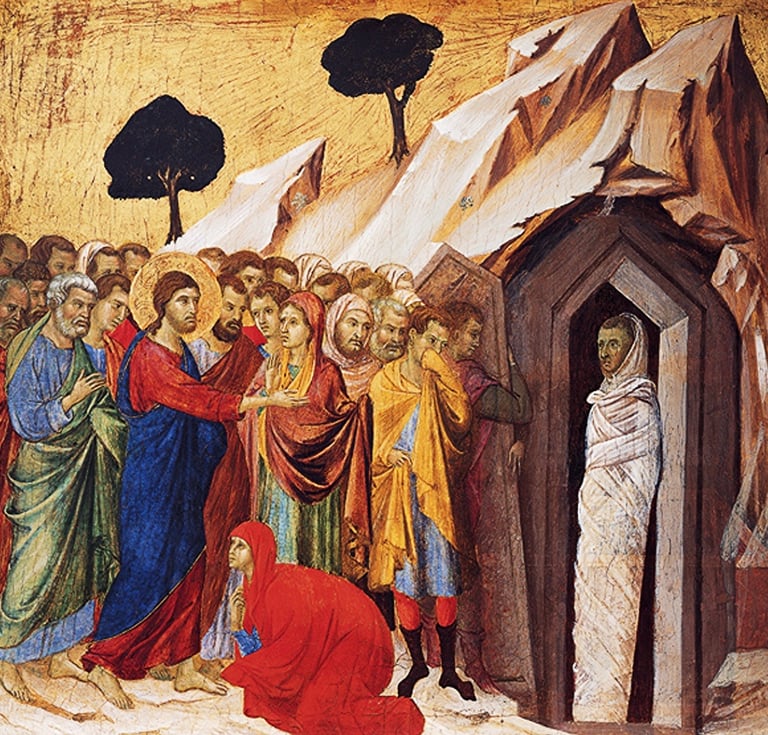

The Raising of Lazarus
painting by: Duccio di Buoninsegna
These spiritual tools (the words of God) repeated by the living spiritual master or found in Scripture, never fail.
In 2 TIMOTHY 3:16 it says that: “All Scripture is given by inspiration of God, and is profitable for doctrine, for reproof, for correction, for instruction in righteousness.”
In the tenth chapter of ACTS 10:35, Peter told his friend Cornelius, and all those gathered around: “In every nation He has those who worship Him and do good deeds and are acceptable to Him,” not because they’re Jew or Gentile but because they please Him. “In every nation,” means people with different customs, foods, dress, histories, beliefs, saints, and Scriptures; acceptable to God because they’re doing the right thing!
The scriptures reveals to us God’s knowledge and His words. The validity of other Scriptures, as I’ve just shown, has been both endorsed and recognized in the Holy Bible.
The Vedas are the Holy Scriptures of India and of all of the Vedas, the Shrimad-Bhagavatam (SHREE-mod-BHA-ga-va-tom) is the most mature, containing the beautiful stories of the Lord. “This (Shrimad-Bhagavatam) propounds the highest truth, which is understandable by those devotees who are fully pure in heart. The highest truth is reality distinguished from illusion for the welfare of all. O expert and thoughtful men, relish Shrimad-Bhagavatam, the mature fruit of the desire tree of Vedic literatures. This Shrimad-Bhagavatam is the literary incarnation of God, and it is compiled by Shrila Vyasadeva, the incarnation of God. It is meant for the ultimate good of all people, and it is all-successful, all-blissful and all-perfect.” (SHRIMAD-BHAGAVATAM, Bhaktivedanta Swami Prabhupada, , 1:1-2-3 & 1:3-40, © BBT-Int’l 1972)
The most famous Scripture in India is the Bhagavad-gita. This popular book has also been called, The Song of God and The Bible of India. Both the Bhagavad-gita and the Shrimad-Bhagavatam contain the knowledge of God, as does the Holy Bible.
Turning to the BHAGAVAD-GITA (10:25, 10:38, 9:16-17, 3:15), the Lord speaks as follows: “I am the transcendental chanting of the Holy Names. Of the wise, I am the wisdom (knowledge). The Vedas are directly manifested from the breathing of the Supreme Personality of Godhead. I am also the Rg (rig), the Sama, Atharva and the Yajur Vedas (Scriptures).”
Spiritual Parts
Returning to the formula: “the right knowledge, the right tools, and the right parts,” as I have attempted to explain, right knowledge can only be found in God. The spiritual master blesses us with this knowledge by his holy words (the right tools), which he reaches out and touches us with (the parts).
Yes, we are the divine parts, each a unique individual, created by God and accepted by the Lord as His parts and parcels. BHAGAVAD-GITA 10:39:“Furthermore, O Arjuna, I am the generating seed of all existences. There is no being (moving or non-moving) that can exist without Me.”
GENESIS 1:27: “So God created man.”
Although we are the divine parts, we are now dangerously afloat within this material ocean of repeated birth and death,on an ill-fated ship destined to sink just as sure as the mighty Titanic.
However, if we let the spiritual master touch us with his divine words—if we are obedient to those words, death will never again be able to lay its horrible hands upon us.
Reincarnation is the cycle of repeated birth & death and even though it is now the 21st Century where reincarnation is more accepted more than ever, I find it sad how so many people are looking forward to their next birth and the necessary suffering and death that is unavoidable once the soul has been embodied within a body. There is actually a widespread dogma being promulgated by the Near Death Experience community, teaching that the only way to grow spiritually is to submit oneself to countless births. NDE experts such as Atwater even suggest that perfection (or spiritual growth) is not even possible without experiencing an opposite and horrific counterbalancing experience. I’m not saying that “this method” doesn’t work, but when leaders of the NDE Community suggest that repeated birth and death is the only wayfor spiritual advancement, then I must protest.
PROVERBS 4:20-22: “My son, attend to my words; incline thine ear unto my sayings. Keep them in the midst of thine heart. For they are (eternal) life unto those that find them.”
The spiritual master does not speculate. He is not sitting there trying to figure out what’s wrong. Rather, he knows exactly what’s amiss because he knows our spiritual blueprint. This is his knowledge. He knows how we are meant to behave (serving God). By holding ourselves out to be touched by his “divine tools” (His words), we can enter into that holy state of being where there is no death.
BHAGAVAD-GITA (8:5-7): ”And whoever, at the end of his life, quits his body remembering Me alone, at once attains My (deathless) nature. Of this there is no doubt. Whatever state of being one remembers when he quits his body, O son of Kunti (Arjuna), that state he will attain without fail. Therefore, Arjuna, you should always think of Me in the form of Krishna and at the same time carry out your prescribed duty. With your activities dedicated to Me and your mind and intelligence fixed on Me, you will attain Me without fail.”
The bicycle mechanic knows what is wrong with the wheel because he knows how it is supposed to behave (spin). It is very simple. The bicycle mechanic can then use his knowledge and the proper tools to fix the defective parts. The master bicycle mechanic only deals with perfect parts. When the bicycle mechanic handles a broken part, he transforms it into a perfect part. In this same way, the spiritual tools (words), when spoken by the spiritual master, can “repair” mankind by touching us is the most remarkable way.
When God blesses us through His beloved servant, it’s as though God, Himself, is touching us. When the governor calls the warden to pardon the prisoner and set him free—when the warden steps up to the cell with the key in his hand to unlock the door, isn’t the all-important hand of the governor actually there, unlocking the door? It will be our eternal blessing and good fortune to let Shrila Prabhupada (or Jesus Christ) touch us.
What is it, then, that the spiritual master is going to address? What is causing the death? What is causing the pain? This is what the spiritual master knows.
The Vedas tell us that he is the “mercy incarnation of the Lord.” He is the perfect captain, guiding us through our troubled waters. Being divinely intelligent, he doesn’t become fooled or diverted by all the junk we come up with. He knows exactly what to touch with his words.
Knowing quite well our stubborn nature, the first thing he touches are our fixed attitudes. You see, unless we are receptive and eager for his help (touch), how are we going to improve our precarious position? If a part is too difficult to reach with the wrench, how is the adjustment going to be made? If the head of the screw is so twisted, how is the screwdriver going to fit into the slot? How are we to have any hope of turning our lives around if we are not receptive? When the mighty Titanic was sinking, many people were warned that the ship was sinking, but the warning was ignored as something impossible. No, we need to let his words touch us.
This is why His Divine Grace Shrila Bhaktisiddhanta (the spiritual master of Shrila Prabhupada) proclaimed: “The transcendental sound has got innumerable potencies. If we are fortunate to receive the sound that is beyond the human scope, we should listen to it. We should spare a portion of our time to receive those sounds. We must not neglect the transcendental sound freely transmitted by agents of the Absolute. We must not show a challenging or rejecting attitude.
“Persons under the influence of such mentality are apt to be disinclined to accept any concrete description of the form and doings of Godhead. They prefer to make their obeisance (homage) to the zone of light and do not consider it their duty to be over-curious or to peep into its hidden secrets.
“Mankind has a natural tendency toward this impersonal idea of Godhead, and it has spread among them like a contagious disease. The idea may be traced to the innate desire of mankind to be freed from all subjection to their sole Governor…which can be effected if He can be proved to be an entity without form. The attempt to make Him impersonal is an attempt to deny His eternal rulership. But the realm of light, according to both the Koran and the Bible, is inhabited by an infinite host of angels with bodies of light who eternally serve Godhead and have an uninterrupted view of Him in His Divine Realm.” (A RAY OF VISHNU, LIVES OF THE VAISHNAVA ACHARYAS, A Ray of Vishnu, Robert Macnaughton,Vol. 1, pp. 106-07, 236-37,240, New Jaipur Press, © 1988)
The very first thing that Lord Krishna addressed when Arjuna asked for help were Arjuna’s faulty ideas. Essentially Lord Krishna called him a fool. But, oh, how mankind hates to hear those words. Instead of becoming receptive and trying to change, we would rather pat each other on the back. “Gee Reverend, you sure are a good shot. Yes sir, I remember the day you put one right between her eyes. Excuse me Reverend. Please pass the venison.”
In order for Arjuna to receive the Lord’s divine touch, first he had to become humble (receptive). Isn’t this what Jesus Christ spoke about when he taught the men from Galilee? MATTHEW 5:3—“Humble men are very fortunate, for the Kingdom of Heaven is given to them.”
Just as the bicycle mechanic’s first contact with a broken bike is with its faulty parts, likewise, the spiritual master first comes to touch our faulty attitudes. If we can just set our pride and our traditions and our religions aside for a few moments (which so many people change over the course of a lifetime anyhow), to hear something new, we can receive the greatest blessing. Again, how is the wrench going to turn the nut if it can’t be reached? This is what Jesus Christ taught when he said, MARK 10:15: “Verily I say unto you, whosoever shall not receive the kingdom of God as a little child, he shall not enter therein.”
Part of my message is that the spiritual master is “the kingdom of God, personified.” Please Lord, let his words fall upon my stubborn heart. Amen.
Unlike the dead matter that bicycles are made from, without a hint of consciousness, we are imbued with life; blessed with a vibrant and eternal existence. BHAGAVAD-GITA (2:20-22): “For the soul there is neither birth nor death at any time. He has not come into being, does not come into being, and will not come into being. He is unborn, eternal, ever-existing and primeval. He is not slain when the body is slain. As a person puts on new garments, giving up old ones, the soul similarly accepts new material bodies, giving up the old and useless ones.”
MATTHEW 10:28: “Don’t be afraid of those who can kill only your bodies, but can’t touch your souls!”
Yes, we are the divinely-conscious parts, and the spiritual master’s words are the divinely-conscious tools, and from the Lord emanates the divinely-perfect knowledge.
God has perfect knowledge: BHAGAVAD-GITA (7.26 & 4.5): “O Arjuna, as the Supreme Personality of Godhead, I know everything that has happened in the past, all that is happening in the present, and all things that are yet to come. Many, many births both you and I have passed. I can remember all of them but you cannot.” Knowing exactly what is best for us, this knowledge is the matchless gift that Shrila Prabhupada came to America with, in 1965.
It is to our eternal well-being to humble ourselves before God’s servant, letting the spiritual master impart “eternal life” unto us. Allow yourself to be touched! Let yourself be blessed! We are our blessings. The proud will never be happy in this world, or the next. We have to let go of our false pride. We have to let go of all the mundane things we love to do. We have to develop new tastes, new habits, and new friendships. We have to embrace our eternal identity. We have to come alive! We have to arouse and invigorate our “deathless-selves.”
One could say that our goal is to become deathless, free from this never-ending cycle of birth and death. This means giving up all those things which oppose our spiritual life, which have nothing to do with the eternal realm, which have nothing to do with the God-given purpose we were created for, and which can only cover us with the crust of material decay.
The head of the screw which needs to be turned is located within our hearts, but if our hearts are kept twisted with our attitudes favoring sin, we will not want to listen to the spiritual master. How many people do not even care about going to church?
The “spiritual classroom” is not so easily entered. If you try to enter intoxicated with sinful activities and a harsh attitude, try as you may, you will fail to hear. This is why the saints first instruct us to repent. But once in your seat, you can learn all you need to know.
Shrila Prabhupada continues: “Our first proposal is that you become sinless. It is not religion. It is a question of becoming sinless. Every religion will say that you become sinless. Every religion. Sinful means, generally, what is against the law of God. That is sinful. Just like, what is criminal? Any action which is against the law of the state, that is criminal. Similarly, sinful means what is against the law of God. That is sinful. But you do not know what is God. You do not know what is the law of God. Therefore you do not know what is sin. A sinful man cannot be intelligent. A God-conscious person having a bad character, it is incompatible. It is not possible. You cannot find fault with him. That is God conscious.” (CONVERSATIONS WITH SHRILA PRABHUPADA, Vol. 7, pp. 36-38 & Vol. 6, pp.288, 299, © BBT-Int’l, 1989)
Surrounded by the wicked Pharisees who were trying to outwit Christ, the Lord turned to their leader and replied: JOHN 8:34-51: “You are slaves of sin; every one of you. And slaves don’t have rights, but the Son has every right there is! So if the Son sets you free (from death), you will indeed be free. I am telling you what I saw when I was with my Father. But you are following the advice of your (earthly) father.”
“Our father is Abraham,” (the Pharisees) declared. ‘No,’ Jesus replied, ‘for if he were, you would follow his good example. But instead you are trying to kill me, and all because I told you the truth I heard from God. Abraham wouldn’t do a thing like that. I have come to you from God. I am not here on my own, but He sent me. Why can’t you understand the things that I am saying? It is because you are prevented from doing so! For you are the children of your father the devil and you love to do the evil things he does. When I tell the truth, you just naturally don’t believe it. Anyone whose Father is God listens gladly to the words of God. Since you don’t, it proves you aren’t His children. With all the earnestness I have, I tell you this—no one who obeys me shall ever die.'”
If we are going to experience our deathlessness, then we need to begin exercising our eternal nature. “Deathless parts” behave like they were intended—to serve God, in loving devotional service. This is what our (spiritual) hands, feet, eyes, nose, ears, tongue, mind, and intelligence are supposed to do—connect with God in loving devotional service.
Previously I had mentioned that Paul refers to spiritual bodies:
2 CORINTHIANS 4:7 & 5:1: “Presently our souls are held in a perishable container, but there will come a time when we shall put on heavenly (deathless)bodies, like new clothes, for we shall not be spirits without bodies.”
Yes, the saints know the art of living spiritually. They know the happiness this brings. They are exceedingly kind. They tell us how we are supposed to behave: activities that will arouse our spiritual bodies.
ROMANS 2:7: “The Lord will give eternal life to those who patiently do the Will of God.”
In summary, the spiritual master says to take the cigarette out of your mouth and, instead, use your spiritual mouth (the divine part), by taking up the activities that it was intended for in the first place: to glorify God and His Holy Name, and to taste all the wonderful foods that have been offered to Him.


The spiritual master also tells us to stop using our legs to hop around on the dance floor. Instead, use our spiritual legs to carry ourselves into the Lord’s temple (or church) where you can dance with the devotees, as taught by Lord Chaitanya and the Holy Bible. PSALMS 149:3: “Let them praise his Name in dance.”
Furthermore, the spiritual master prods us to use our spiritual eyes and to use our spiritual intelligence by reading the Scriptures. We have to transfer our reading propensities from mundane literatures to the Holy Scriptures which give us eternal, life-giving nourishment. The spiritual master doesn’t instruct us not to read, but to read, instead, those things that pertain to our eternal life. Or, as St. Gregory of Sinai says in THE WAY OF A PILGRIM (p.180): “When you take upon yourself the activity of prayer, then you should read only those books which contain teachings about interior life, about temperance and prayer.”
Use your spiritual body, starting today! Turn off the radio and its mundane music and talk radio. Use your ears to hear the Lord’s Holy Name. If we want to stay alive forever, then we must act alive forever. CHAITANYA-CHARITAMRITA, MADHYA-LILA (22:105): “One who hears the Hare Krishna mantra thus vibrated is awakened to spiritual consciousness.”
It’s as if there are two large wheels. The holy wheel on the right is rolling toward our Lord, while the wheel on the left is rolling away from Him. Which wheel are we going to help turn? The choice is ours, but remember, we can’t push them both. 1 CORINTHIANS 10:21: “You cannot drink from the cup at the Lord’s table and at Satan’s table, too. You cannot eat bread both at the Lord’s table and at Satan’s table.”
Concerning the wheel on the right, this is the “wheel of loving devotional service,” joyously turned by those great souls free from illusion. Every effort is an act of devotion. Together, their loving-devotional service turns this sacred wheel and just like the wheel in a music box it, too, makes sweet music as it turns. Shrila Prabhupada has even taught us the song: Hare Krishna Hare Krishna Krishna Krishna Hare Hare Hare Rama Hare Rama Rama Rama Hare Hare.
This song is pure nectar for the fully pure in heart: “I do not know how much nectar the two syllables ‘krish-na’ have produced. When the Holy Name of Krishna is chanted, it appears to dance within the mouth. We then desire many, many mouths. When that Name enters the holes of the ears, we desire many millions of ears. And when the Holy Name dances in the courtyard of the heart, it conquers the activities of the mind, and therefore all the senses become inert.” (CHAITANYA-CHARITAMRITA, Antya-lila 1:99, © BBT-Int’l, 1983)
But what is that horrible sound I hear coming from the other wheel? It is not a song, at all. Oh, it’s the sound of death. The sorrow of mankind. The screams of our little fawn and her brother as they watch in terror as their defenseless mother is ruthlessly gunned down on a Sunday afternoon; the cries of our small calf being butchered. It is the sound of dying children, the sounds of war, the sounds of hate and greed.
Yes, it is you and I whom the spiritual master wants to touch with “the words emanating from his lotus-mouth.” These are the tools that he wants to touch us with. He wants to touch our spiritual feet, touch our spiritual hands, touch our spiritual eyes, touch our spiritual ears, touch our spiritual minds, and touch our spiritual intelligence. He wants to help us embrace and celebrate our eternal nature as servants of God.
However, there is a price. We have to use them. But the reward is that perfect parts don’t die. Perfect parts don’t need to be repaired. You don’t need any tools if the bicycle is working properly. It’s just there to use. The deathless person is simply serving God with all his heart, mind, and soul.
St. Therese of Lisieux: “A soul on fire with love (of God) cannot remain inactive. If you only knew what projects I have in mind; what I will do with things when I am in heaven.”
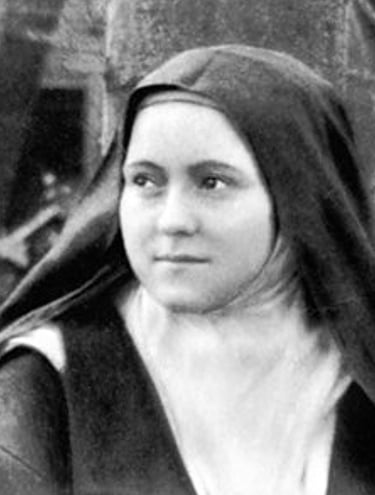

St. Therese of Lisieux
Chapter Five
The Good News of the Vaishnava Gospel
